Redefining diabetes care and AI strategy
Redefining diabetes care and AI strategy
Redefining diabetes care and AI strategy
2022-present · Launched · Web · iOS
2022-present · Launched · Web · iOS
2022-present · Launched · Web · iOS
Redefining diabetes care & AI strategy
2022-present · Launched · Web · iOS
I led the design and launch of Verily’s Lightpath clinician console, a scalable platform for diabetes management used by providers to document and coordinate patient care. This product renewed a $1M+ contract with Blue Cross Blue Shield Highmark and, for the first time in Verily's history, was selected as a finalist for the BCBS Federal Employee Program—a potential $100M contract covering 5.7 million patients. My work laid the foundation for Verily’s broader care strategy, including the upcoming AI-driven 2026 Lightpath Metabolic program. I also established design systems and launch processes, now leveraged company-wide.
I led the design and launch of Verily’s Lightpath clinician console, a scalable platform for diabetes management used by providers to document and coordinate patient care. This product renewed a $1M+ contract with Blue Cross Blue Shield Highmark and, for the first time in Verily's history, was selected as a finalist for the BCBS Federal Employee Program—a potential $100M contract covering 5.7 million patients. My work laid the foundation for Verily’s broader care strategy, including the upcoming AI-driven 2026 Lightpath Metabolic program. I also established design systems and launch processes, now leveraged company-wide.
I led the design and launch of Verily’s Lightpath clinician console, a scalable platform for diabetes management used by providers to document and coordinate patient care. This product renewed a $1M+ contract with Blue Cross Blue Shield Highmark and, for the first time in Verily's history, was selected as a finalist for the BCBS Federal Employee Program—a potential $100M contract covering 5.7 million patients. My work laid the foundation for Verily’s broader care strategy, including the upcoming AI-driven 2026 Lightpath Metabolic program. I also established design systems and launch processes, now leveraged company-wide.
Led the design and launch of Verily's Lightpath clinician console, a scalable diabetes management platform. Renewed a $1M+ contract with Blue Cross Blue Shield Highmark and became a finalist for the BCBS Federal Employee Program—a potential $100M contract covering 5.7 million patients. Laid the foundation for Verily’s broader care strategy, including the AI-driven 2026 Lightpath Metabolic program, and established company-wide design systems and processes.
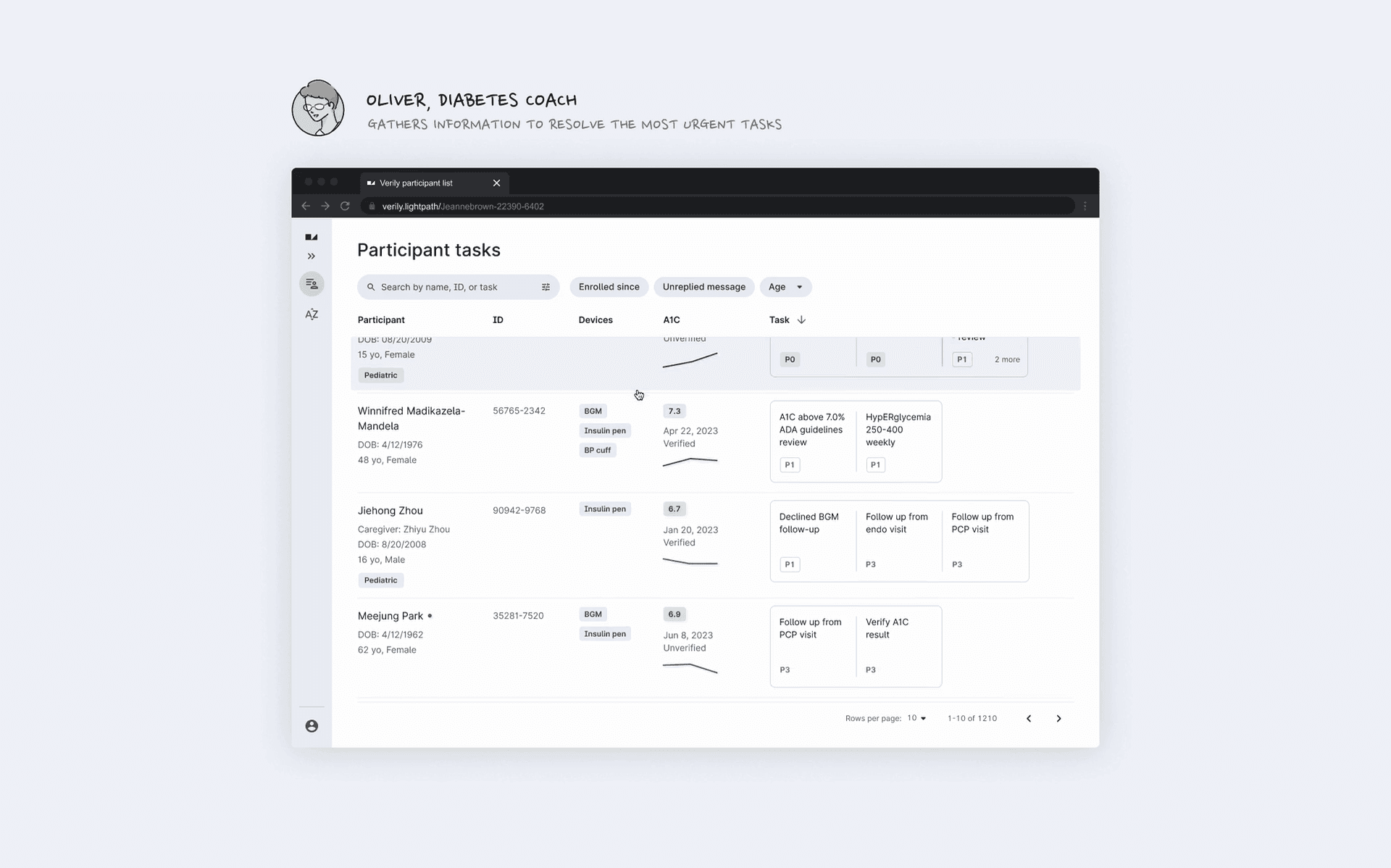



Lightpath clinician console launched Jan 2024 to BCBS Highmark providers.
Lightpath clinician console launched Jan 2024 to BCBS Highmark providers.
Lightpath clinician console launched Jan 2024 to BCBS Highmark providers.

Lightpath clinician console launched Jan 2024 to BCBS Highmark providers.
Problem
Problem
Problem
In 2023, Verily faced systemic challenges while being tasked with launching the new flagship care product, Lightpath.
In 2023, Verily faced systemic challenges while being tasked with launching the new flagship care product, Lightpath.
In 2023, Verily faced systemic challenges while being tasked with launching the new flagship care product, Lightpath.
1
1
1
No product vision
No product vision
No product vision
Neither clinician nor patient platforms had a clear product direction, causing internal misalignment and eroding trust with existing clients.
Neither clinician nor patient platforms had a clear product direction, causing internal misalignment and eroding trust with existing clients.
Neither clinician nor patient platforms had a clear product direction, causing internal misalignment and eroding trust with existing clients.
2
2
2
Clinician inefficiencies
Clinician inefficiencies
Clinician inefficiencies
Outdated workflows forced excessive administrative tasks, delaying care decisions and frustrating clinicians, diminishing platform value.
Outdated workflows forced excessive administrative tasks, delaying care decisions and frustrating clinicians, diminishing platform value.
Outdated workflows forced excessive administrative tasks, delaying care decisions and frustrating clinicians, diminishing platform value.
3
3
3
Rigid patient app architecture
Rigid patient app architecture
Rigid patient app architecture
The single-condition framework stifled scalability, experimentation, and app updates. As a result, 60% of enrolled patients dropped off by the 3rd month.
The single-condition framework stifled scalability, experimentation, and app updates. As a result, 60% of enrolled patients dropped off by the 3rd month.
The single-condition framework stifled scalability, experimentation, and updates, resulting in 60% patient dropoff by month 3.
4
4
4
Blocked development
Blocked development
Blocked development
The clinician console lacked collaborative UX-eng processes, leading to undefined milestones, blocked development, and repeated launch delays.
The clinician console lacked collaborative UX-eng processes, leading to undefined milestones, blocked development, and repeated launch delays.
The clinician console lacked collaborative UX-eng processes, leading to undefined milestones, blocked development, and repeated launch delays.
Problem
In 2023, Verily faced systemic challenges while being tasked with launching the new flagship care product, Lightpath.
Skepticism about the business value of AI
1
Former leaders saw AI features as too conceptual, doubting their practical impact on healthcare and on our business.
Blocked development
4
The clinician console lacked collaborative UX-eng processes, leading to undefined milestones, blocked development, and repeated launch delays.
Leadership and clinical resistance
3
Leadership and clinical teams resisted AI, questioning its relevance and fearing job displacement.
Lack of unified AI initiative and vision
2
Early AI efforts were siloed and scattered. Without a clear strategy for AI integration, stakeholder skepticism.
Solution
Solution
Solution
Solution
I redefined Verily’s new clinician console and proposed a scalable architecture for the patient app, Verily Me, driving improvements across both products.
I redefined Verily’s new clinician console and proposed a scalable architecture for the patient app, Verily Me, driving improvements across both products.
I redefined Verily’s new clinician console and proposed a scalable architecture for the patient app, Verily Me, driving improvements across both products.
I redefined Verily’s new clinician console and proposed a scalable architecture for the patient app, Verily Me, driving improvements across both products.
1
1
1
1
Clarifying vision and alignment
Clarifying vision and alignment
Clarifying vision and alignment
Clarifying vision and alignment




I led a cross-functional workshop to define a cohesive vision for Lightpath, improving clinician efficiency through features such as dynamic task prioritization, giving clinicians faster access to critical decision-making information.
I led a cross-functional workshop to define a cohesive vision for Lightpath, improving clinician efficiency through features such as dynamic task prioritization, giving clinicians faster access to critical decision-making information.
I led a cross-functional workshop to define a cohesive vision for Lightpath, improving clinician efficiency through features such as dynamic task prioritization, giving clinicians faster access to critical decision-making information.
I led a cross-functional workshop to define a cohesive vision for Lightpath, improving clinician efficiency through features such as dynamic task prioritization, giving clinicians faster access to critical decision-making information.
Service diagram captures services, user actions, and data flows to identify gaps and drive cross-functional and cross-org alignment.
Service diagram captures services, user actions, and data flows to identify gaps and drive cross-functional and cross-org alignment.
Service diagram captures services, user actions, and data flows to identify gaps and drive cross-functional and cross-org alignment.
Service diagram captures services, user actions, and data flows to identify gaps and drive cross-functional and cross-org alignment.





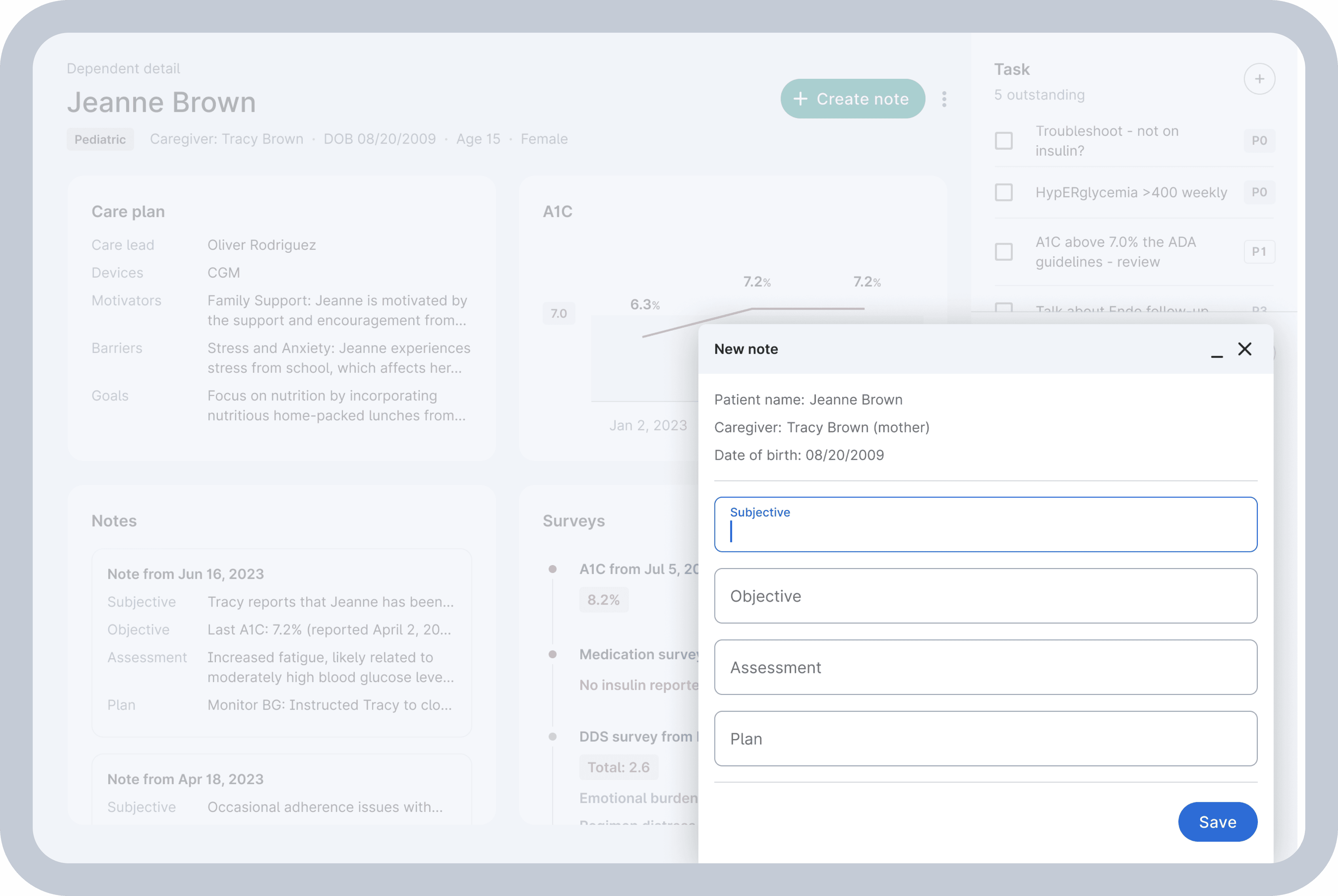




Leveraged SOAP notes—the standard for medical documentation—and introduced patient-specific tabs critical for HIPAA compliance.
Leveraged SOAP notes—the standard for medical documentation—and introduced patient-specific tabs critical for HIPAA compliance.
Leveraged SOAP notes—the standard for medical documentation—and introduced patient-specific tabs critical for HIPAA compliance.
Leveraged SOAP notes—the standard for medical documentation—and introduced patient-specific tabs critical for HIPAA compliance.
2
2
2
2
Developing an adaptive foundation
Developing an adaptive foundation
Developing an adaptive foundation
Developing an adaptive foundation
I built Lightpath to scale across multiple clinical conditions, user needs, and products. Today, more than 5 Verily products use this structure, adopted by design systems. My earlier work on the former patient app laid the foundation for experimentation and flexibility, later leveraged by Verily Me, now 5-star-rated on iOS and Android.
I built Lightpath to scale across multiple clinical conditions, user needs, and products. Today, more than 5 Verily products use this structure, adopted by design systems. My earlier work on the former patient app laid the foundation for experimentation and flexibility, later leveraged by Verily Me, now 5-star-rated on iOS and Android.
I built Lightpath to scale across multiple clinical conditions, user needs, and products. Today, more than 5 Verily products use this structure, adopted by design systems. My earlier work on the former patient app laid the foundation for experimentation and flexibility, later leveraged by Verily Me, now 5-star-rated on iOS and Android.
I built Lightpath to scale across multiple clinical conditions, user needs, and products. Today, more than 5 Verily products use this structure, adopted by design systems. My earlier work on the former patient app laid the foundation for experimentation and flexibility, later leveraged by Verily Me, now 5-star-rated on iOS and Android.




The framework I developed for Lightpath is used across multiple products across Verily.
The framework I developed for Lightpath is used across multiple products across Verily.
The framework I developed for Lightpath is used across multiple products across Verily.
The framework I developed for Lightpath is used across multiple products across Verily.
Patient app foundation
Patient app foundation
Patient app foundation
Dynamic framework
Dynamic framework
Dynamic framework
Patients engaged with less than 8% of the home screen content, but the static framework continued to display that underutilized content. I built an adaptive structure that evolves based on user signals and clinical needs, now leveraged by Verily Me.
Patients engaged with less than 8% of the home screen content, but the static framework continued to display that underutilized content. I built an adaptive structure that evolves based on user signals and clinical needs, now leveraged by Verily Me.
Patients engaged with less than 8% of the home screen content, but the static framework continued to display that underutilized content. I built an adaptive structure that evolves based on user signals and clinical needs, now leveraged by the new patient app, Verily Me.
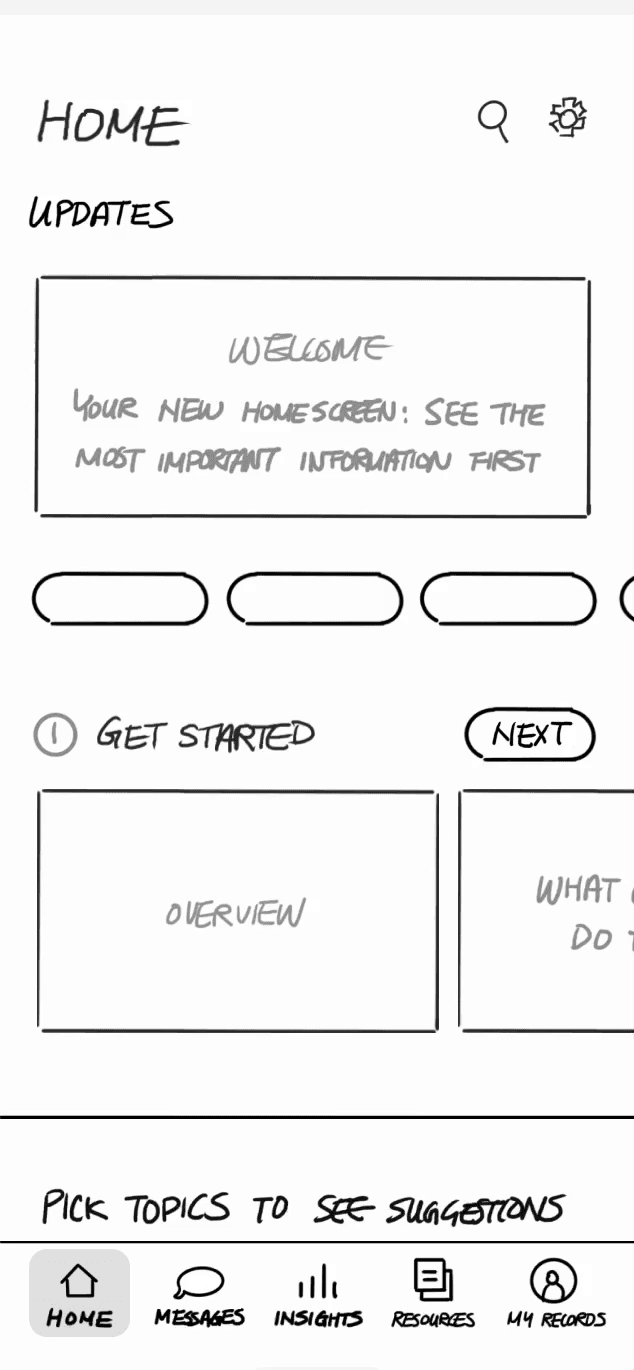

Patient app foundation
Creating a dynamic framework
Patients engaged with less than 8% of the home screen content, but the static framework continued to display that underutilized content. I built an adaptive structure that evolves based on user signals and clinical needs, now leveraged by Verily Me.
Patients engaged with less than 8% of the home screen content, but the static framework continued to display that underutilized content. I built an adaptive structure that evolves based on user signals and clinical needs, now leveraged by Verily Me.
Clear information architecture
Clear information architecture
Clear information architecture
Clear information architecture
Patients reported difficulty finding key information throughout the previous makeshift information architecture (IA). In response, I restructured the IA to prioritize critical actions, making them easily accessible, driving engagement.
Patients reported difficulty finding key information throughout the previous makeshift information architecture (IA). In response, I restructured the IA to prioritize critical actions, making them easily accessible, driving engagement.
Patients reported difficulty finding key information throughout the previous makeshift information architecture (IA). In response, I restructured the IA to prioritize critical actions, making them easily accessible, driving engagement.
Patients reported difficulty finding key information throughout the previous makeshift information architecture (IA). In response, I restructured the IA to prioritize critical actions, making them easily accessible, driving engagement.




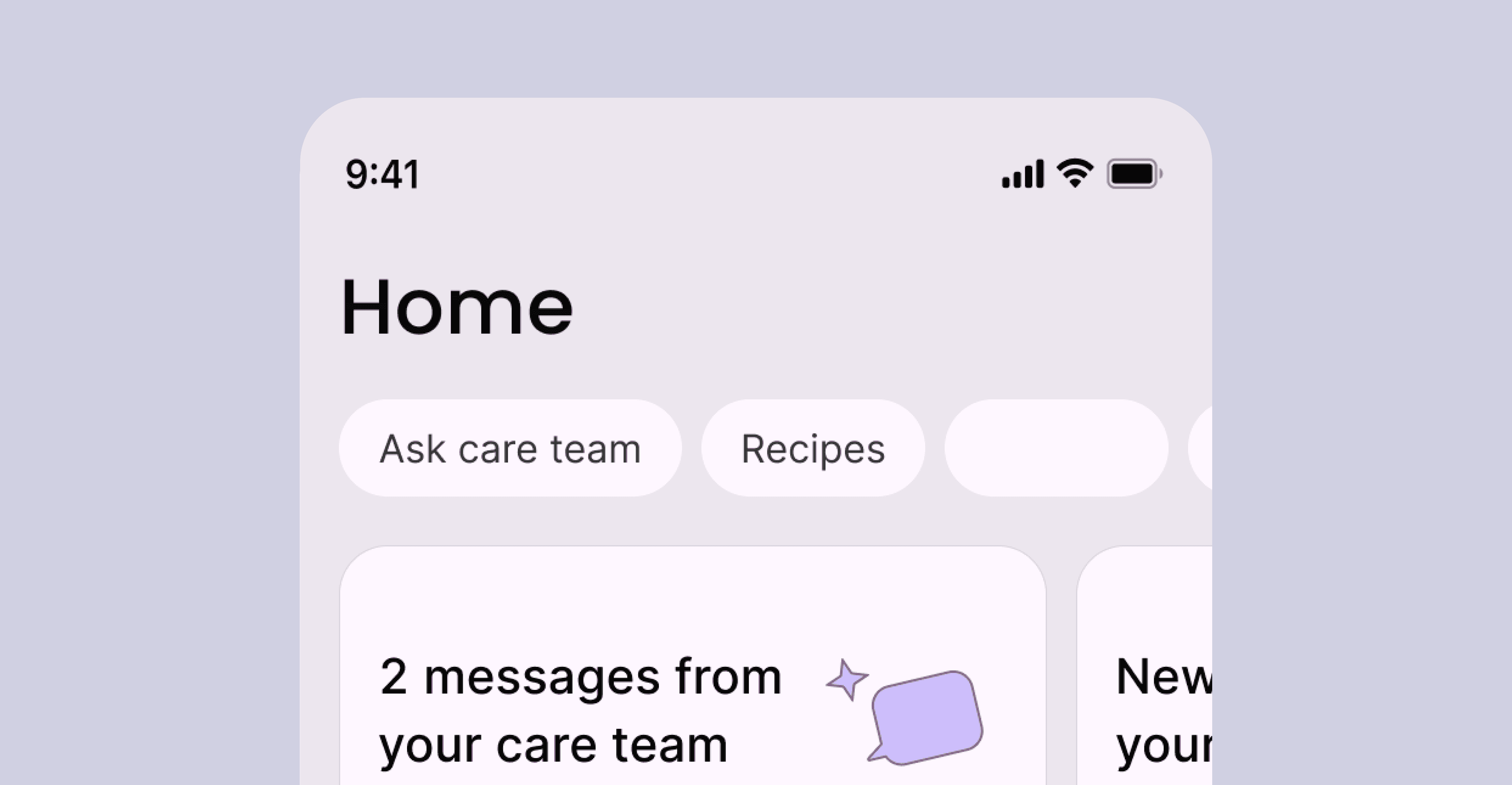



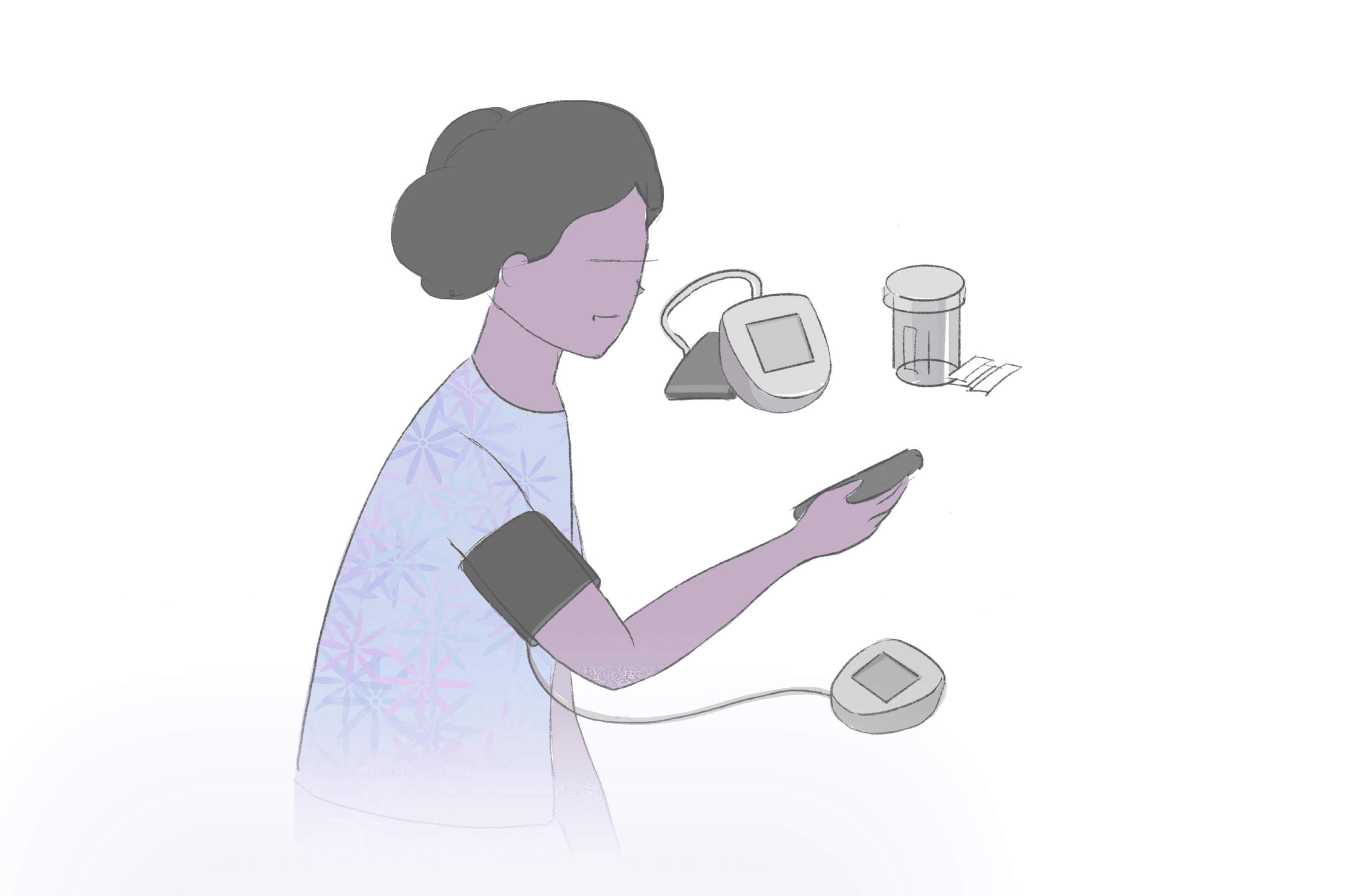







Strategic pivot toward patient self-management
Strategic pivot toward patient self-management
Strategic pivot toward patient self-management
Strategic pivot toward patient self-management
After discovering that 40% of clinical tasks were self-manageable, I shifted the app toward patient self-service, setting a new standard for Verily’s patient care strategy.
After discovering that 40% of clinical tasks were self-manageable, I shifted the app toward patient self-service, setting a new standard for Verily’s patient care strategy.
After discovering that 40% of clinical tasks were self-manageable, I shifted the app toward patient self-service, setting a new standard for Verily’s patient care strategy.
After discovering that 40% of clinical tasks were self-manageable, I shifted the app toward patient self-service, setting a new standard for Verily’s patient care strategy.
3
3
3
Establishing a comprehensive launch process
Establishing a comprehensive launch process
Establishing a comprehensive launch process
I created a UX-led launch framework for Lightpath, ensuring collaboration between UX, product, and engineering. This process resolved 200+ high-priority issues and became Verily’s standard for future launches.
I created a UX-led launch framework for Lightpath, ensuring collaboration between UX, product, and engineering. This process resolved 200+ high-priority issues and became Verily’s standard for future launches.
I created a UX-led launch framework for Lightpath, ensuring collaboration between UX, product, and engineering. This process resolved 200+ high-priority issues and became Verily’s standard for future launches.
3
Establishing a comprehensive launch process
I created a UX-led launch framework for Lightpath, ensuring collaboration between UX, product, and engineering. This process resolved 200+ high-priority issues and became Verily’s standard for future launches.

1
Setting the vision amid uncertainty
After restructuring, I transitioned from the patient app to lead the Lightpath clinician console, drafting a clinician workflow vision in four weeks under leadership’s year-end mandate.

2
Pitching vision for leadership buy-in
I led a pitch process with product leads, demonstrating clinical workflow improvements and securing client & leadership buy-in for Lightpath’s product direction.

3
Building and planning a scalable foundation for Lightpath
I designed and led the build of a scalable foundation for clinical conditions, workflows, and user needs through cross-functional workshops, planning, and biweekly sprints.
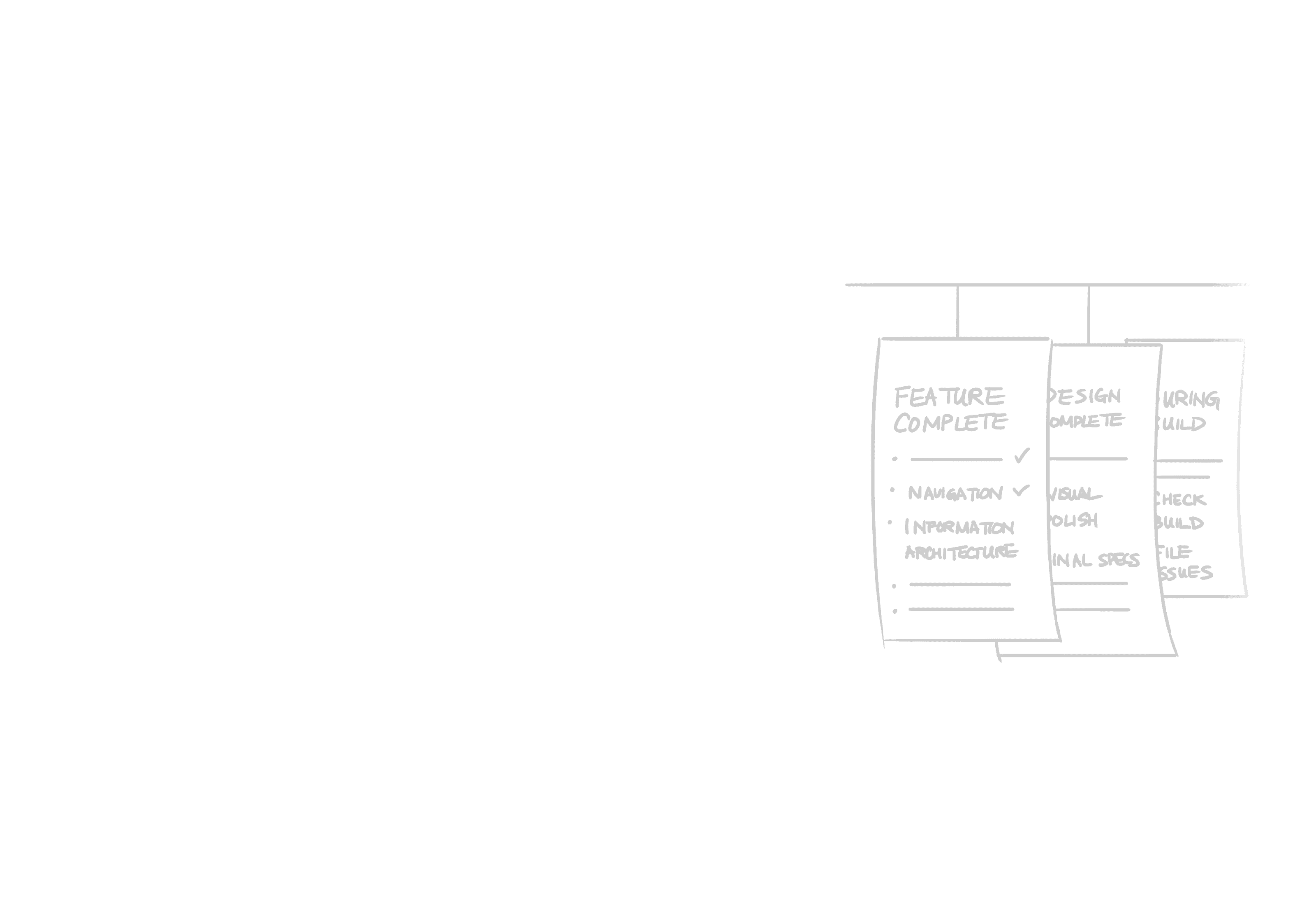
4
Resolving bottlenecks with UX-led launch process
I introduced UX-led processes, clarifying terms such as “code freeze” and “feature complete,” improving collaboration, handoffs, and issue prioritization with engineering.

5
Escalating to resolve critical build access issues
I led a strategic escalation to resolve test build access issues, securing leadership support for mandatory fix and an 8-week extension to address top issues.

6
Final product launch and UX-led process adoption
Lightpath launched, renewing a $1M+ contract with Highmark BCBS. My UX-led process became the Verily standard, driving future launches and ensuring UX accountability.

1
Setting the vision amid uncertainty
After restructuring, I transitioned from the patient app to lead the Lightpath clinician console, drafting a clinician workflow vision in four weeks under leadership’s year-end mandate.

2
Pitching vision for leadership buy-in
I led a pitch process with product leads, demonstrating clinical workflow improvements and securing client & leadership buy-in for Lightpath’s product direction.

3
Building and planning a scalable foundation for Lightpath
I designed and led the build of a scalable foundation for clinical conditions, workflows, and user needs through cross-functional workshops, planning, and biweekly sprints.

4
Resolving bottlenecks with UX-led launch process
I introduced UX-led processes, clarifying terms such as “code freeze” and “feature complete,” improving collaboration, handoffs, and issue prioritization with engineering.

5
Escalating to resolve critical build access issues
I led a strategic escalation to resolve test build access issues, securing leadership support for mandatory fix and an 8-week extension to address top issues.

6
Final product launch and UX-led process adoption
Lightpath launched, renewing a $1M+ contract with Highmark BCBS. My UX-led process became the Verily standard, driving future launches and ensuring UX accountability.

1
Setting the vision amid uncertainty
After restructuring, I transitioned from the patient app to lead the Lightpath clinician console, drafting a clinician workflow vision in four weeks under leadership’s year-end mandate.

2
Pitching vision for leadership buy-in
I led a pitch process with product leads, demonstrating clinical workflow improvements and securing client & leadership buy-in for Lightpath’s product direction.

3
Building and planning a scalable foundation for Lightpath
I designed and led the build of a scalable foundation for clinical conditions, workflows, and user needs through cross-functional workshops, planning, and biweekly sprints.

4
Resolving bottlenecks with UX-led launch process
I introduced UX-led processes, clarifying terms such as “code freeze” and “feature complete,” improving collaboration, handoffs, and issue prioritization with engineering.

5
Escalating to resolve critical build access issues
I led a strategic escalation to resolve test build access issues, securing leadership support for mandatory fix and an 8-week extension to address top issues.

6
Final product launch and UX-led process adoption
Lightpath launched, renewing a $1M+ contract with Highmark BCBS. My UX-led process became the Verily standard, driving future launches and ensuring UX accountability.

1
Setting the vision amid uncertainty
After restructuring, I transitioned from the patient app to lead the Lightpath clinician console, drafting a clinician workflow vision in four weeks under leadership’s year-end mandate.

2
Pitching vision for leadership buy-in
I led a pitch process with product leads, demonstrating clinical workflow improvements and securing client & leadership buy-in for Lightpath’s product direction.

3
Building and planning a scalable foundation for Lightpath
I designed and led the build of a scalable foundation for clinical conditions, workflows, and user needs through cross-functional workshops, planning, and biweekly sprints.

4
Resolving bottlenecks with UX-led launch process
I introduced UX-led processes, clarifying terms such as “code freeze” and “feature complete,” improving collaboration, handoffs, and issue prioritization with engineering.

5
Escalating to resolve critical build access issues
I led a strategic escalation to resolve test build access issues, securing leadership support for mandatory fix and an 8-week extension to address top issues.

6
Final product launch and UX-led process adoption
Lightpath launched, renewing a $1M+ contract with Highmark BCBS. My UX-led process became the Verily standard, driving future launches and ensuring UX accountability.

1
Setting the vision amid uncertainty
After restructuring, I transitioned from the patient app to lead the Lightpath clinician console, drafting a clinician workflow vision in four weeks under leadership’s year-end mandate.

2
Pitching vision for leadership buy-in
I led a pitch process with product leads, demonstrating clinical workflow improvements and securing client & leadership buy-in for Lightpath’s product direction.

3
Building and planning a scalable foundation for Lightpath
I designed and led the build of a scalable foundation for clinical conditions, workflows, and user needs through cross-functional workshops, planning, and biweekly sprints.

4
Resolving bottlenecks with UX-led launch process
I introduced UX-led processes, clarifying terms such as “code freeze” and “feature complete,” improving collaboration, handoffs, and issue prioritization with engineering.

5
Escalating to resolve critical build access issues
I led a strategic escalation to resolve test build access issues, securing leadership support for mandatory fix and an 8-week extension to address top issues.

6
Final product launch and UX-led process adoption
Lightpath launched, renewing a $1M+ contract with Highmark BCBS. My UX-led process became the Verily standard, driving future launches and ensuring UX accountability.

1
Setting the vision amid uncertainty
After restructuring, I transitioned from the patient app to lead the Lightpath clinician console, drafting a clinician workflow vision in four weeks under leadership’s year-end mandate.

2
Pitching vision for leadership buy-in
I led a pitch process with product leads, demonstrating clinical workflow improvements and securing client & leadership buy-in for Lightpath’s product direction.

3
Building and planning a scalable foundation for Lightpath
I designed and led the build of a scalable foundation for clinical conditions, workflows, and user needs through cross-functional workshops, planning, and biweekly sprints.

4
Resolving bottlenecks with UX-led launch process
I introduced UX-led processes, clarifying terms such as “code freeze” and “feature complete,” improving collaboration, handoffs, and issue prioritization with engineering.

5
Escalating to resolve critical build access issues
I led a strategic escalation to resolve test build access issues, securing leadership support for mandatory fix and an 8-week extension to address top issues.

6
Final product launch and UX-led process adoption
Lightpath launched, renewing a $1M+ contract with Highmark BCBS. My UX-led process became the Verily standard, driving future launches and ensuring UX accountability.

1
Setting the vision amid uncertainty
After restructuring, I transitioned from the patient app to lead the Lightpath clinician console, drafting a clinician workflow vision in four weeks under leadership’s year-end mandate.

2
Pitching vision for leadership buy-in
I led a pitch process with product leads, demonstrating clinical workflow improvements and securing client & leadership buy-in for Lightpath’s product direction.

3
Building and planning a scalable foundation for Lightpath
I designed and led the build of a scalable foundation for clinical conditions, workflows, and user needs through cross-functional workshops, planning, and biweekly sprints.

4
Resolving bottlenecks with UX-led launch process
I introduced UX-led processes, clarifying terms such as “code freeze” and “feature complete,” improving collaboration, handoffs, and issue prioritization with engineering.

5
Escalating to resolve critical build access issues
I led a strategic escalation to resolve test build access issues, securing leadership support for mandatory fix and an 8-week extension to address top issues.

6
Final product launch and UX-led process adoption
Lightpath launched, renewing a $1M+ contract with Highmark BCBS. My UX-led process became the Verily standard, driving future launches and ensuring UX accountability.

1
Setting the vision amid uncertainty
After restructuring, I transitioned from the patient app to lead the Lightpath clinician console, drafting a clinician workflow vision in four weeks under leadership’s year-end mandate.

2
Pitching vision for leadership buy-in
I led a pitch process with product leads, demonstrating clinical workflow improvements and securing client & leadership buy-in for Lightpath’s product direction.

3
Building and planning a scalable foundation for Lightpath
I designed and led the build of a scalable foundation for clinical conditions, workflows, and user needs through cross-functional workshops, planning, and biweekly sprints.

4
Resolving bottlenecks with UX-led launch process
I introduced UX-led processes, clarifying terms such as “code freeze” and “feature complete,” improving collaboration, handoffs, and issue prioritization with engineering.

5
Escalating to resolve critical build access issues
I led a strategic escalation to resolve test build access issues, securing leadership support for mandatory fix and an 8-week extension to address top issues.

6
Final product launch and UX-led process adoption
Lightpath launched, renewing a $1M+ contract with Highmark BCBS. My UX-led process became the Verily standard, driving future launches and ensuring UX accountability.

1
Setting the vision amid uncertainty
After restructuring, I transitioned from the patient app to lead the Lightpath clinician console, drafting a clinician workflow vision in four weeks under leadership’s year-end mandate.

2
Pitching vision for leadership buy-in
I led a pitch process with product leads, demonstrating clinical workflow improvements and securing client & leadership buy-in for Lightpath’s product direction.

3
Building and planning a scalable foundation for Lightpath
I designed and led the build of a scalable foundation for clinical conditions, workflows, and user needs through cross-functional workshops, planning, and biweekly sprints.

4
Resolving bottlenecks with UX-led launch process
I introduced UX-led processes, clarifying terms such as “code freeze” and “feature complete,” improving collaboration, handoffs, and issue prioritization with engineering.

5
Escalating to resolve critical build access issues
I led a strategic escalation to resolve test build access issues, securing leadership support for mandatory fix and an 8-week extension to address top issues.

6
Final product launch and UX-led process adoption
Lightpath launched, renewing a $1M+ contract with Highmark BCBS. My UX-led process became the Verily standard, driving future launches and ensuring UX accountability.

1
Setting the vision amid uncertainty
After restructuring, I transitioned from the patient app to lead the Lightpath clinician console, drafting a clinician workflow vision in four weeks under leadership’s year-end mandate.

2
Pitching vision for leadership buy-in
I led a pitch process with product leads, demonstrating clinical workflow improvements and securing client & leadership buy-in for Lightpath’s product direction.

3
Building and planning a scalable foundation for Lightpath
I designed and led the build of a scalable foundation for clinical conditions, workflows, and user needs through cross-functional workshops, planning, and biweekly sprints.

4
Resolving bottlenecks with UX-led launch process
I introduced UX-led processes, clarifying terms such as “code freeze” and “feature complete,” improving collaboration, handoffs, and issue prioritization with engineering.

5
Escalating to resolve critical build access issues
I led a strategic escalation to resolve test build access issues, securing leadership support for mandatory fix and an 8-week extension to address top issues.

6
Final product launch and UX-led process adoption
Lightpath launched, renewing a $1M+ contract with Highmark BCBS. My UX-led process became the Verily standard, driving future launches and ensuring UX accountability.

1
Setting the vision amid uncertainty
After restructuring, I transitioned from the patient app to lead the Lightpath clinician console, drafting a clinician workflow vision in four weeks under leadership’s year-end mandate.

2
Pitching vision for leadership buy-in
I led a pitch process with product leads, demonstrating clinical workflow improvements and securing client & leadership buy-in for Lightpath’s product direction.

3
Building and planning a scalable foundation for Lightpath
I designed and led the build of a scalable foundation for clinical conditions, workflows, and user needs through cross-functional workshops, planning, and biweekly sprints.

4
Resolving bottlenecks with UX-led launch process
I introduced UX-led processes, clarifying terms such as “code freeze” and “feature complete,” improving collaboration, handoffs, and issue prioritization with engineering.

5
Escalating to resolve critical build access issues
I led a strategic escalation to resolve test build access issues, securing leadership support for mandatory fix and an 8-week extension to address top issues.

6
Final product launch and UX-led process adoption
Lightpath launched, renewing a $1M+ contract with Highmark BCBS. My UX-led process became the Verily standard, driving future launches and ensuring UX accountability.

1
Setting the vision amid uncertainty
After restructuring, I transitioned from the patient app to lead the Lightpath clinician console, drafting a clinician workflow vision in four weeks under leadership’s year-end mandate.

2
Pitching vision for leadership buy-in
I led a pitch process with product leads, demonstrating clinical workflow improvements and securing client & leadership buy-in for Lightpath’s product direction.

3
Building and planning a scalable foundation for Lightpath
I designed and led the build of a scalable foundation for clinical conditions, workflows, and user needs through cross-functional workshops, planning, and biweekly sprints.

4
Resolving bottlenecks with UX-led launch process
I introduced UX-led processes, clarifying terms such as “code freeze” and “feature complete,” improving collaboration, handoffs, and issue prioritization with engineering.

5
Escalating to resolve critical build access issues
I led a strategic escalation to resolve test build access issues, securing leadership support for mandatory fix and an 8-week extension to address top issues.

6
Final product launch and UX-led process adoption
Lightpath launched, renewing a $1M+ contract with Highmark BCBS. My UX-led process became the Verily standard, driving future launches and ensuring UX accountability.

1
Setting the vision amid uncertainty
After restructuring, I transitioned from the patient app to lead the Lightpath clinician console, drafting a clinician workflow vision in four weeks under leadership’s year-end mandate.

2
Pitching vision for leadership buy-in
I led a pitch process with product leads, demonstrating clinical workflow improvements and securing client & leadership buy-in for Lightpath’s product direction.

3
Building and planning a scalable foundation for Lightpath
I designed and led the build of a scalable foundation for clinical conditions, workflows, and user needs through cross-functional workshops, planning, and biweekly sprints.

4
Resolving bottlenecks with UX-led launch process
I introduced UX-led processes, clarifying terms such as “code freeze” and “feature complete,” improving collaboration, handoffs, and issue prioritization with engineering.
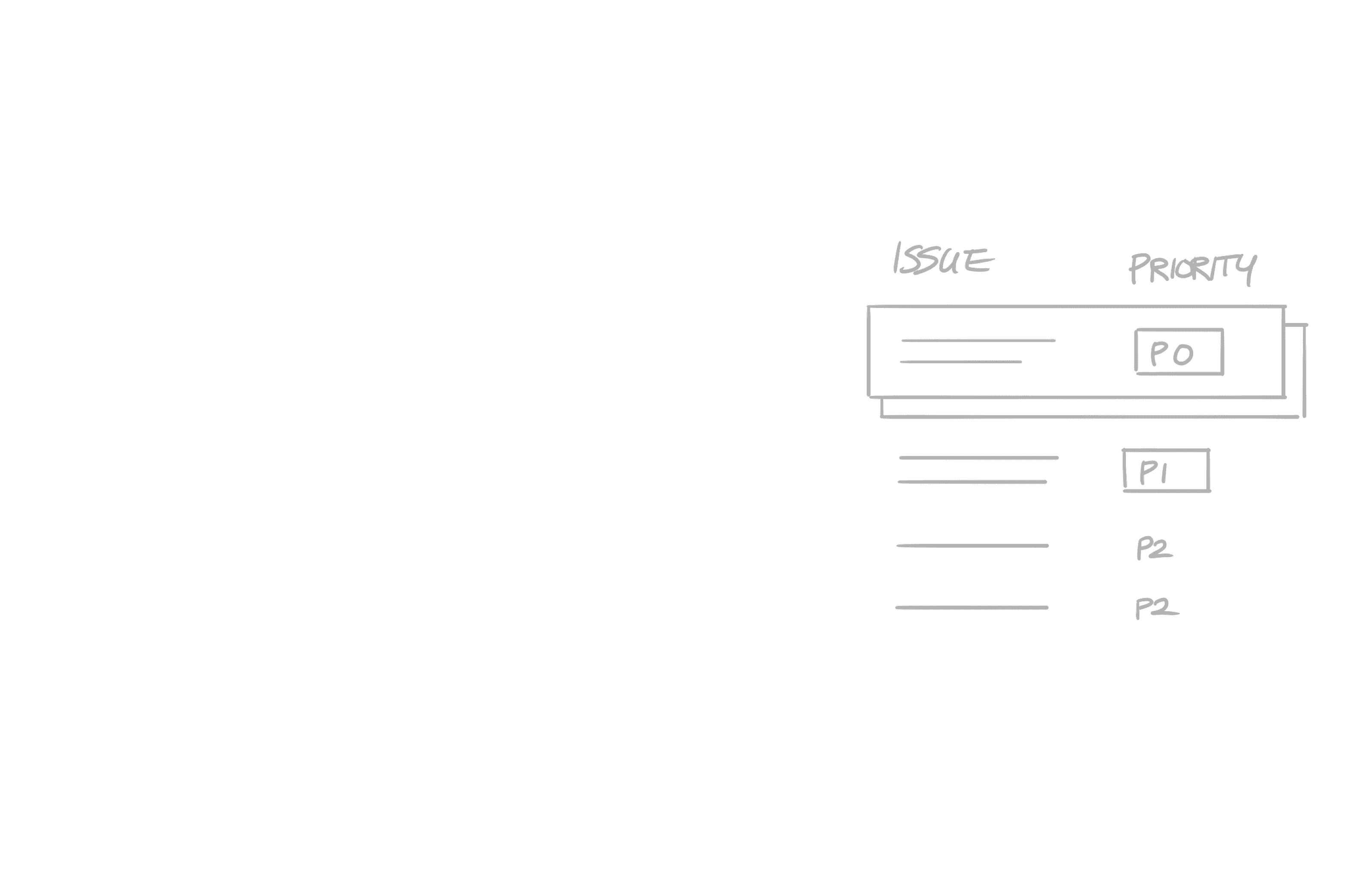
5
Escalating to resolve critical build access issues
I led a strategic escalation to resolve test build access issues, securing leadership support for mandatory access and an 8-week extension for the launch to fix top issues.

6
Final product launch and UX-led process adoption
Lightpath launched, renewing a $1M+ contract with Highmark BCBS. My UX-led process became the Verily standard, driving future launches and ensuring UX accountability.

1
Setting the vision amid uncertainty
After restructuring, I transitioned from the patient app to lead the Lightpath clinician console, drafting a clinician workflow vision in four weeks under leadership’s year-end mandate.

2
Pitching vision for leadership buy-in
I led a pitch process with product leads, demonstrating clinical workflow improvements and securing client & leadership buy-in for Lightpath’s product direction.

3
Building and planning a scalable foundation for Lightpath
I designed and led the build of a scalable foundation for clinical conditions, workflows, and user needs through cross-functional workshops, planning, and biweekly sprints.

4
Resolving bottlenecks with UX-led launch process
I introduced UX-led processes, clarifying terms such as “code freeze” and “feature complete,” improving collaboration, handoffs, and issue prioritization with engineering.

5
Escalating to resolve critical build access issues
I led a strategic escalation to resolve test build access issues, securing leadership support for mandatory access and an 8-week extension for the launch to fix top issues.

6
Final product launch and UX-led process adoption
Lightpath launched, renewing a $1M+ contract with Highmark BCBS. My UX-led process became the Verily standard, driving future launches and ensuring UX accountability.

1
Setting the vision amid uncertainty
After restructuring, I transitioned from the patient app to lead the Lightpath clinician console, drafting a clinician workflow vision in four weeks under leadership’s year-end mandate.

2
Pitching vision for leadership buy-in
I led a pitch process with product leads, demonstrating clinical workflow improvements and securing client & leadership buy-in for Lightpath’s product direction.

3
Building and planning a scalable foundation for Lightpath
I designed and led the build of a scalable foundation for clinical conditions, workflows, and user needs through cross-functional workshops, planning, and biweekly sprints.

4
Resolving bottlenecks with UX-led launch process
I introduced UX-led processes, clarifying terms such as “code freeze” and “feature complete,” improving collaboration, handoffs, and issue prioritization with engineering.

5
Escalating to resolve critical build access issues
I led a strategic escalation to resolve test build access issues, securing leadership support for mandatory access and an 8-week extension for the launch to fix top issues.

6
Final product launch and UX-led process adoption
Lightpath launched, renewing a $1M+ contract with Highmark BCBS. My UX-led process became the Verily standard, driving future launches and ensuring UX accountability.

1
Setting the vision amid uncertainty
After restructuring, I transitioned from the patient app to lead the Lightpath clinician console, drafting a clinician workflow vision in four weeks under leadership’s year-end mandate.

2
Pitching vision for leadership buy-in
I led a pitch process with product leads, demonstrating clinical workflow improvements and securing client & leadership buy-in for Lightpath’s product direction.

3
Building and planning a scalable foundation for Lightpath
I designed and led the build of a scalable foundation for clinical conditions, workflows, and user needs through cross-functional workshops, planning, and biweekly sprints.

4
Resolving bottlenecks with UX-led launch process
I introduced UX-led processes, clarifying terms such as “code freeze” and “feature complete,” improving collaboration, handoffs, and issue prioritization with engineering.

5
Escalating to resolve critical build access issues
I led a strategic escalation to resolve test build access issues, securing leadership support for mandatory access and an 8-week extension for the launch to fix top issues.

6
Final product launch and UX-led process adoption
Lightpath launched, renewing a $1M+ contract with Highmark BCBS. My UX-led process became the Verily standard, driving future launches and ensuring UX accountability.

1
Setting the vision amid uncertainty
After restructuring, I transitioned from the patient app to lead the Lightpath clinician console, drafting a clinician workflow vision in four weeks under leadership’s year-end mandate.

2
Pitching vision for leadership buy-in
I led a pitch process with product leads, demonstrating clinical workflow improvements and securing client & leadership buy-in for Lightpath’s product direction.

3
Building and planning a scalable foundation for Lightpath
I designed and led the build of a scalable foundation for clinical conditions, workflows, and user needs through cross-functional workshops, planning, and biweekly sprints.

4
Resolving bottlenecks with UX-led launch process
I introduced UX-led processes, clarifying terms such as “code freeze” and “feature complete,” improving collaboration, handoffs, and issue prioritization with engineering.

5
Escalating to resolve critical build access issues
I led a strategic escalation to resolve test build access issues, securing leadership support for mandatory access and an 8-week extension for the launch to fix top issues.

6
Final product launch and UX-led process adoption
Lightpath launched, renewing a $1M+ contract with Highmark BCBS. My UX-led process became the Verily standard, driving future launches and ensuring UX accountability.

1
Setting the vision amid uncertainty
After restructuring, I transitioned from the patient app to lead the Lightpath clinician console, drafting a clinician workflow vision in four weeks under leadership’s year-end mandate.

2
Pitching vision for leadership buy-in
I led a pitch process with product leads, demonstrating clinical workflow improvements and securing client & leadership buy-in for Lightpath’s product direction.

3
Building and planning a scalable foundation for Lightpath
I designed and led the build of a scalable foundation for clinical conditions, workflows, and user needs through cross-functional workshops, planning, and biweekly sprints.

4
Resolving bottlenecks with UX-led launch process
I introduced UX-led processes, clarifying terms such as “code freeze” and “feature complete,” improving collaboration, handoffs, and issue prioritization with engineering.

5
Escalating to resolve critical build access issues
I led a strategic escalation to resolve test build access issues, securing leadership support for mandatory access and an 8-week extension for the launch to fix top issues.

6
Final product launch and UX-led process adoption
Lightpath launched, renewing a $1M+ contract with Highmark BCBS. My UX-led process became the Verily standard, driving future launches and ensuring UX accountability.

1
Setting the vision amid uncertainty
After restructuring, I transitioned from the patient app to lead the Lightpath clinician console, drafting a clinician workflow vision in four weeks under leadership’s year-end mandate.

2
Pitching vision for leadership buy-in
I led a pitch process with product leads, demonstrating clinical workflow improvements and securing client & leadership buy-in for Lightpath’s product direction.

3
Building and planning a scalable foundation for Lightpath
I designed and led the build of a scalable foundation for clinical conditions, workflows, and user needs through cross-functional workshops, planning, and biweekly sprints.

4
Resolving bottlenecks with UX-led launch process
I introduced UX-led processes, clarifying terms such as “code freeze” and “feature complete,” improving collaboration, handoffs, and issue prioritization with engineering.

5
Escalating to resolve critical build access issues
I led a strategic escalation to resolve test build access issues, securing leadership support for mandatory access and an 8-week extension for the launch to fix top issues.

6
Final product launch and UX-led process adoption
Lightpath launched, renewing a $1M+ contract with Highmark BCBS. My UX-led process became the Verily standard, driving future launches and ensuring UX accountability.

1
Setting the vision amid uncertainty
After restructuring, I transitioned from the patient app to lead the Lightpath clinician console, drafting a clinician workflow vision in four weeks under leadership’s year-end mandate.

2
Pitching vision for leadership buy-in
I led a pitch process with product leads, demonstrating clinical workflow improvements and securing client & leadership buy-in for Lightpath’s product direction.

3
Building and planning a scalable foundation for Lightpath
I designed and led the build of a scalable foundation for clinical conditions, workflows, and user needs through cross-functional workshops, planning, and biweekly sprints.

4
Resolving bottlenecks with UX-led launch process
I introduced UX-led processes, clarifying terms such as “code freeze” and “feature complete,” improving collaboration, handoffs, and issue prioritization with engineering.

5
Escalating to resolve critical build access issues
I led a strategic escalation to resolve test build access issues, securing leadership support for mandatory access and an 8-week extension for the launch to fix top issues.

6
Final product launch and UX-led process adoption
Lightpath launched, renewing a $1M+ contract with Highmark BCBS. My UX-led process became the Verily standard, driving future launches and ensuring UX accountability.

1
Setting the vision amid uncertainty
After restructuring, I transitioned from the patient app to lead the Lightpath clinician console, drafting a clinician workflow vision in four weeks under leadership’s year-end mandate.

2
Pitching vision for leadership buy-in
I led a pitch process with product leads, demonstrating clinical workflow improvements and securing client & leadership buy-in for Lightpath’s product direction.

3
Building and planning a scalable foundation for Lightpath
I designed and led the build of a scalable foundation for clinical conditions, workflows, and user needs through cross-functional workshops, planning, and biweekly sprints.

4
Resolving bottlenecks with UX-led launch process
I introduced UX-led processes, clarifying terms such as “code freeze” and “feature complete,” improving collaboration, handoffs, and issue prioritization with engineering.

5
Escalating to resolve critical build access issues
I led a strategic escalation to resolve test build access issues, securing leadership support for mandatory fix and an 8-week extension to address top issues.

6
Final product launch and UX-led process adoption
Lightpath launched, renewing a $1M+ contract with Highmark BCBS. My UX-led process became the Verily standard, driving future launches and ensuring UX accountability.

1
Setting the vision amid uncertainty
After restructuring, I transitioned from the patient app to lead the Lightpath clinician console, drafting a clinician workflow vision in four weeks under leadership’s year-end mandate.

2
Pitching vision for leadership buy-in
I led a pitch process with product leads, demonstrating clinical workflow improvements and securing client & leadership buy-in for Lightpath’s product direction.

3
Building and planning a scalable foundation for Lightpath
I designed and led the build of a scalable foundation for clinical conditions, workflows, and user needs through cross-functional workshops, planning, and biweekly sprints.

4
Resolving bottlenecks with UX-led launch process
I introduced UX-led processes, clarifying terms such as “code freeze” and “feature complete,” improving collaboration, handoffs, and issue prioritization with engineering.

5
Escalating to resolve critical build access issues
I led a strategic escalation to resolve test build access issues, securing leadership support for mandatory fix and an 8-week extension to address top issues.

6
Final product launch and UX-led process adoption
Lightpath launched, renewing a $1M+ contract with Highmark BCBS. My UX-led process became the Verily standard, driving future launches and ensuring UX accountability.

1
Setting the vision amid uncertainty
After restructuring, I transitioned from the patient app to lead the Lightpath clinician console, drafting a clinician workflow vision in four weeks under leadership’s year-end mandate.

2
Pitching vision for leadership buy-in
I led a pitch process with product leads, demonstrating clinical workflow improvements and securing client & leadership buy-in for Lightpath’s product direction.

3
Building and planning a scalable foundation for Lightpath
I designed and led the build of a scalable foundation for clinical conditions, workflows, and user needs through cross-functional workshops, planning, and biweekly sprints.

4
Resolving bottlenecks with UX-led launch process
I introduced UX-led processes, clarifying terms such as “code freeze” and “feature complete,” improving collaboration, handoffs, and issue prioritization with engineering.

5
Escalating to resolve critical build access issues
I led a strategic escalation to resolve test build access issues, securing leadership support for mandatory fix and an 8-week extension to address top issues.

6
Final product launch and UX-led process adoption
Lightpath launched, renewing a $1M+ contract with Highmark BCBS. My UX-led process became the Verily standard, driving future launches and ensuring UX accountability.

1
Setting the vision amid uncertainty
After restructuring, I transitioned from the patient app to lead the Lightpath clinician console, drafting a clinician workflow vision in four weeks under leadership’s year-end mandate.

2
Pitching vision for leadership buy-in
I led a pitch process with product leads, demonstrating clinical workflow improvements and securing client & leadership buy-in for Lightpath’s product direction.

3
Building and planning a scalable foundation for Lightpath
I designed and led the build of a scalable foundation for clinical conditions, workflows, and user needs through cross-functional workshops, planning, and biweekly sprints.

4
Resolving bottlenecks with UX-led launch process
I introduced UX-led processes, clarifying terms such as “code freeze” and “feature complete,” improving collaboration, handoffs, and issue prioritization with engineering.

5
Escalating to resolve critical build access issues
I led a strategic escalation to resolve test build access issues, securing leadership support for mandatory fix and an 8-week extension to address top issues.

6
Final product launch and UX-led process adoption
Lightpath launched, renewing a $1M+ contract with Highmark BCBS. My UX-led process became the Verily standard, driving future launches and ensuring UX accountability.

1
Setting the vision amid uncertainty
After restructuring, I transitioned from the patient app to lead the Lightpath clinician console, drafting a clinician workflow vision in four weeks under leadership’s year-end mandate.

2
Pitching vision to leadership
I led a pitch process with product leads, demonstrating clinical workflow improvements and securing client & leadership buy-in for Lightpath’s product direction.

3
Building and planning a scalable foundation for Lightpath
I designed and led the build of a scalable foundation for clinical conditions, workflows, and user needs through cross-functional workshops, planning, and sprints.
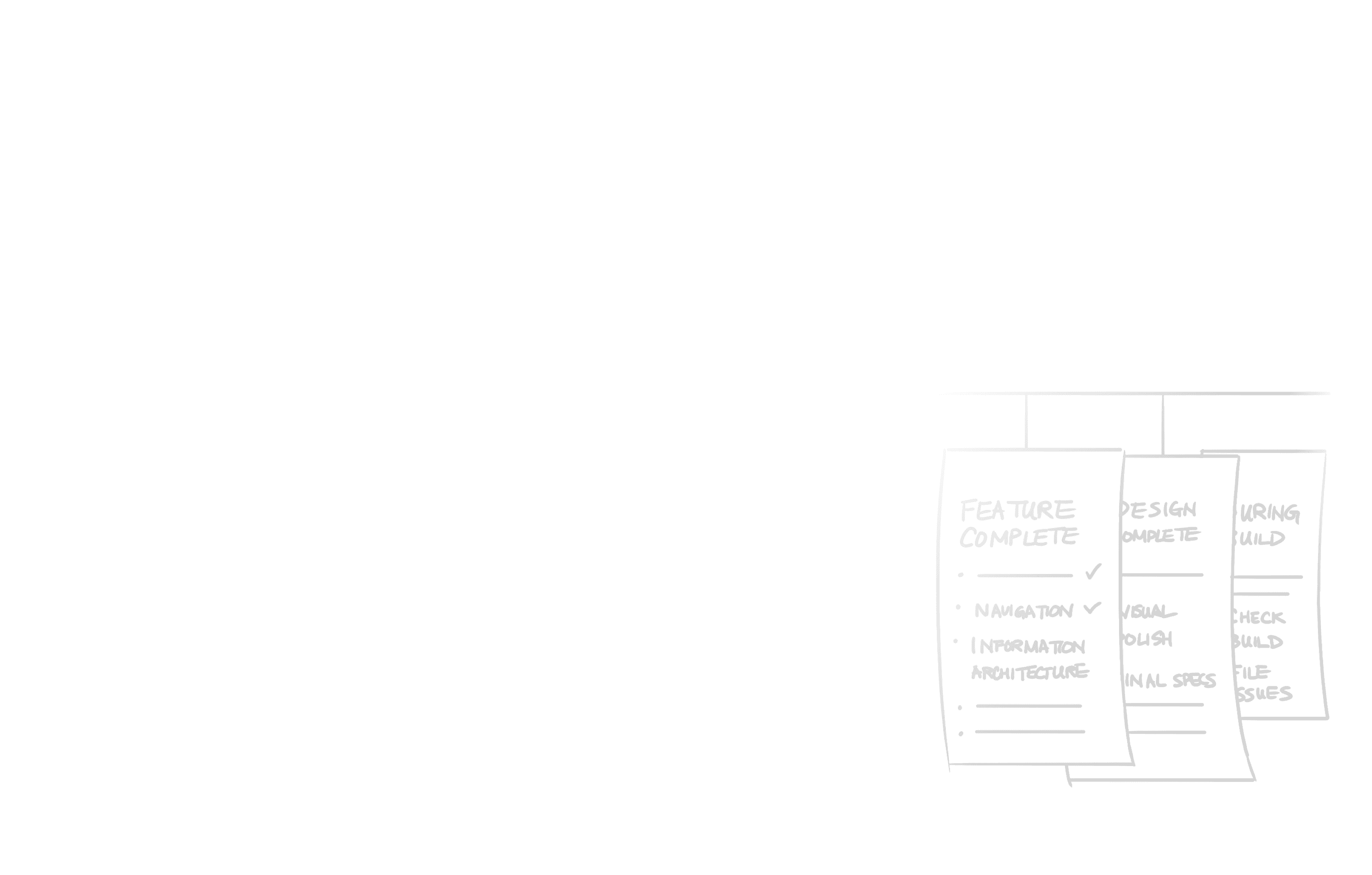
4
Resolving bottlenecks with UX-led launch process
I introduced UX-led processes, clarifying terms such as “code freeze” and “feature complete,” improving collaboration, handoffs, and issue prioritization with eng.

5
Escalating to resolve critical build access issues
I led a strategic escalation to resolve test build access issues, securing leadership support for mandatory fix and an 8-week extension to address top issues.

6
Final product launch and UX-led process adoption
Lightpath launched, renewing a $1M+ contract with Highmark BCBS. My UX-led process became the company standard, driving future launches and ensuring UX accountability.

1
Setting the vision amid uncertainty
After restructuring, I transitioned from the patient app to lead the Lightpath clinician console, drafting a clinician workflow vision in four weeks under leadership’s year-end mandate.

2
Pitching vision to leadership
I led a pitch process with product leads, demonstrating clinical workflow improvements and securing client & leadership buy-in for Lightpath’s product direction.

3
Building and planning a scalable foundation for Lightpath
I designed and led the build of a scalable foundation for clinical conditions, workflows, and user needs through cross-functional workshops, planning, and sprints.

4
Resolving bottlenecks with UX-led launch process
I introduced UX-led processes, clarifying terms such as “code freeze” and “feature complete,” improving collaboration, handoffs, and issue prioritization with eng.

5
Escalating to resolve critical build access issues
I led a strategic escalation to resolve test build access issues, securing leadership support for mandatory fix and an 8-week extension to address top issues.

6
Final product launch and UX-led process adoption
Lightpath launched, renewing a $1M+ contract with Highmark BCBS. My UX-led process became the company standard, driving future launches and ensuring UX accountability.

1
Setting the vision amid uncertainty
After restructuring, I transitioned from the patient app to lead the Lightpath clinician console, drafting a clinician workflow vision in four weeks under leadership’s year-end mandate.

2
Pitching vision to leadership
I led a pitch process with product leads, demonstrating clinical workflow improvements and securing client & leadership buy-in for Lightpath’s product direction.

3
Building and planning a scalable foundation for Lightpath
I designed and led the build of a scalable foundation for clinical conditions, workflows, and user needs through cross-functional workshops, planning, and sprints.

4
Resolving bottlenecks with UX-led launch process
I introduced UX-led processes, clarifying terms such as “code freeze” and “feature complete,” improving collaboration, handoffs, and issue prioritization with eng.

5
Escalating to resolve critical build access issues
I led a strategic escalation to resolve test build access issues, securing leadership support for mandatory fix and an 8-week extension to address top issues.

6
Final product launch and UX-led process adoption
Lightpath launched, renewing a $1M+ contract with Highmark BCBS. My UX-led process became the company standard, driving future launches and ensuring UX accountability.

1
Setting the vision amid uncertainty
After restructuring, I transitioned from the patient app to lead the Lightpath clinician console, drafting a clinician workflow vision in four weeks under leadership’s year-end mandate.

2
Pitching vision to leadership
I led a pitch process with product leads, demonstrating clinical workflow improvements and securing client & leadership buy-in for Lightpath’s product direction.

3
Building and planning a scalable foundation for Lightpath
I designed and led the build of a scalable foundation for clinical conditions, workflows, and user needs through cross-functional workshops, planning, and sprints.

4
Resolving bottlenecks with UX-led launch process
I introduced UX-led processes, clarifying terms such as “code freeze” and “feature complete,” improving collaboration, handoffs, and issue prioritization with eng.

5
Escalating to resolve critical build access issues
I led a strategic escalation to resolve test build access issues, securing leadership support for mandatory fix and an 8-week extension to address top issues.

6
Final product launch and UX-led process adoption
Lightpath launched, renewing a $1M+ contract with Highmark BCBS. My UX-led process became the company standard, driving future launches and ensuring UX accountability.

1
Setting the vision amid uncertainty
After restructuring, I transitioned from the patient app to lead the Lightpath clinician console, drafting a clinician workflow vision in four weeks under leadership’s year-end mandate.

2
Pitching vision to leadership
I led a pitch process with product leads, demonstrating clinical workflow improvements and securing client & leadership buy-in for Lightpath’s product direction.

3
Building and planning a scalable foundation for Lightpath
I designed and led the build of a scalable foundation for clinical conditions, workflows, and user needs through cross-functional workshops, planning, and sprints.

4
Resolving bottlenecks with UX-led launch process
I introduced UX-led processes, clarifying terms such as “code freeze” and “feature complete,” improving collaboration, handoffs, and issue prioritization with eng.

5
Escalating to resolve critical build access issues
I led a strategic escalation to resolve test build access issues, securing leadership support for mandatory fix and an 8-week extension to address top issues.

6
Final product launch and UX-led process adoption
Lightpath launched, renewing a $1M+ contract with Highmark BCBS. My UX-led process became the company standard, driving future launches and ensuring UX accountability.

1
Setting the vision amid uncertainty
After restructuring, I transitioned from the patient app to lead the Lightpath clinician console, drafting a clinician workflow vision in four weeks under leadership’s year-end mandate.

2
Pitching vision to leadership
I led a pitch process with product leads, demonstrating clinical workflow improvements and securing client & leadership buy-in for Lightpath’s product direction.

3
Building and planning a scalable foundation for Lightpath
I designed and led the build of a scalable foundation for clinical conditions, workflows, and user needs through cross-functional workshops, planning, and sprints.

4
Resolving bottlenecks with UX-led launch process
I introduced UX-led processes, clarifying terms such as “code freeze” and “feature complete,” improving collaboration, handoffs, and issue prioritization with eng.

5
Escalating to resolve critical build access issues
I led a strategic escalation to resolve test build access issues, securing leadership support for mandatory fix and an 8-week extension to address top issues.

6
Final product launch and UX-led process adoption
Lightpath launched, renewing a $1M+ contract with Highmark BCBS. My UX-led process became the company standard, driving future launches and ensuring UX accountability.

1
Setting the vision amid uncertainty
After restructuring, I transitioned from the patient app to lead the Lightpath clinician console, drafting a clinician workflow vision in four weeks under leadership’s year-end mandate.

2
Pitching vision to leadership
I led a pitch process with product leads, demonstrating clinical workflow improvements and securing client & leadership buy-in for Lightpath’s product direction.

3
Building and planning a scalable foundation for Lightpath
I designed and led the build of a scalable foundation for clinical conditions, workflows, and user needs through cross-functional workshops, planning, and sprints.

4
Resolving bottlenecks with UX-led launch process
I introduced UX-led processes, clarifying terms such as “code freeze” and “feature complete,” improving collaboration, handoffs, and issue prioritization with eng.

5
Escalating to resolve critical build access issues
I led a strategic escalation to resolve test build access issues, securing leadership support for mandatory fix and an 8-week extension to address top issues.

6
Final product launch and UX-led process adoption
Lightpath launched, renewing a $1M+ contract with Highmark BCBS. My UX-led process became the company standard, driving future launches and ensuring UX accountability.

1
Setting the vision amid uncertainty
After restructuring, I transitioned from the patient app to lead the Lightpath clinician console, drafting a clinician workflow vision in four weeks under leadership’s year-end mandate.

2
Pitching vision to leadership
I led a pitch process with product leads, demonstrating clinical workflow improvements and securing client & leadership buy-in for Lightpath’s product direction.

3
Building and planning a scalable foundation for Lightpath
I designed and led the build of a scalable foundation for clinical conditions, workflows, and user needs through cross-functional workshops, planning, and sprints.

4
Resolving bottlenecks with UX-led launch process
I introduced UX-led processes, clarifying terms such as “code freeze” and “feature complete,” improving collaboration, handoffs, and issue prioritization with eng.

5
Escalating to resolve critical build access issues
I led a strategic escalation to resolve test build access issues, securing leadership support for mandatory fix and an 8-week extension to address top issues.

6
Final product launch and UX-led process adoption
Lightpath launched, renewing a $1M+ contract with Highmark BCBS. My UX-led process became the company standard, driving future launches and ensuring UX accountability.
4
4
4
Securing leadership buy-in
Securing leadership buy-in
Securing leadership buy-in
My work on Lightpath helped secure Verily’s first multi-year, $1M+ contract under the One Verily brand. It also set the stage for Verily’s upcoming AI-driven Lightpath Metabolic program, launching in 2026.
My work on Lightpath helped secure Verily’s first multi-year, $1M+ contract under the One Verily brand. It also set the stage for Verily’s upcoming AI-driven Lightpath Metabolic program, launching in 2026.
My work on Lightpath helped secure Verily’s first multi-year, $1M+ contract under the One Verily brand. It also set the stage for Verily’s upcoming AI-driven Lightpath Metabolic program, launching in 2026.
4
Securing leadership buy-in
My work on Lightpath helped secure Verily’s first multi-year, $1M+ contract under the One Verily brand. It also set the stage for Verily’s upcoming AI-driven Lightpath Metabolic program, launching in 2026.
Driving AI Adoption and Strategy
Driving AI Adoption and Strategy
Driving AI Adoption and Strategy
Driving AI Adoption and Strategy
I led the transformation toward AI adoption in a previously resistant organization by forming alliances with data science teams, driving AI education, and aligning AI efforts with business goals. These initiatives now form the foundation of Verily’s 2026 AI product strategy.
I led the transformation toward AI adoption in a previously resistant organization by forming alliances with data science teams, driving AI education, and aligning AI efforts with business goals. These initiatives now form the foundation of Verily’s 2026 AI product strategy.
I led the transformation toward AI adoption in a previously resistant organization by forming alliances with data science teams, driving AI education, and aligning AI efforts with business goals. These initiatives now form the foundation of Verily’s 2026 AI product strategy.
I led the transformation toward AI adoption in a previously resistant organization by forming alliances with data science teams, driving AI education, and aligning AI efforts with business goals. These initiatives now form the foundation of Verily’s 2026 AI product strategy.
Problem
Aligning AI capabilities with business goals
Pitched AI-driven features as key methods to achieve business goals, leveraging capabilities such as summarization and transcription. Now, AI is central to Verily’s 2026 care product strategy.
Securing buy-in through cross-functional workshops
Led cross-functional workshops, presented AI prototypes (NLP, summarization), and aligned AI with business goals, gaining early buy-in.
Establishing AI strategy across teams
Led strategy workshops, aligning product, data science, and engineering teams on AI’s role. AI workstreams were added to Verily’s 2026 roadmap.
Problems
Problems
Problems
Leadership and clinical resistance
Leadership and clinical resistance
Leadership and clinical resistance
Leadership and clinical stakeholders resisted the idea of AI, questioning its relevance and fearing job displacement.
Leadership and clinical stakeholders resisted the idea of AI, questioning its relevance and fearing job displacement.
Leadership and clinical stakeholders resisted the idea of AI, questioning its relevance and fearing job displacement.
Lack of unified AI initiative and vision
Lack of unified AI initiative and vision
Lack of unified AI initiative and vision
Early AI efforts were disjointed. Without a unified AI effort, the work stream faced skepticism.
Early AI efforts were disjointed. Without a unified AI effort, the work stream faced skepticism.
Early AI efforts were disjointed. Without a unified AI effort, the work stream faced skepticism.
Skepticism about the value of AI
Skepticism about the value of AI
Skepticism about the value of AI
Former leaders saw AI features as too conceptual, doubting their practical impact on our business.
Former leaders saw AI features as too conceptual, doubting their practical impact on our business.
Former leaders saw AI features as too conceptual, doubting their practical impact on our business.
Solution
Solution
Solution
Solution
I developed strategies to build a pro-AI culture and accelerate AI adoption:
I developed strategies to build a pro-AI culture and accelerate AI adoption:
I developed strategies to build a pro-AI culture and accelerate AI adoption:
I developed strategies to build a pro-AI culture and accelerate AI adoption:


1
Overcoming resistance to AI
Leadership and clinical teams initially resisted AI, seeing it as irrelevant for healthcare. I had to prove its potential for improving workflows and aligning it with business goals.

2
Workshops to build vision
I led a cross-functional workshop with UX, engineering, and data science teams, showcasing AI-driven tools to improve clinical documentation and summarization. This workshop unified the team around AI’s potential to enhance clinician efficiency.
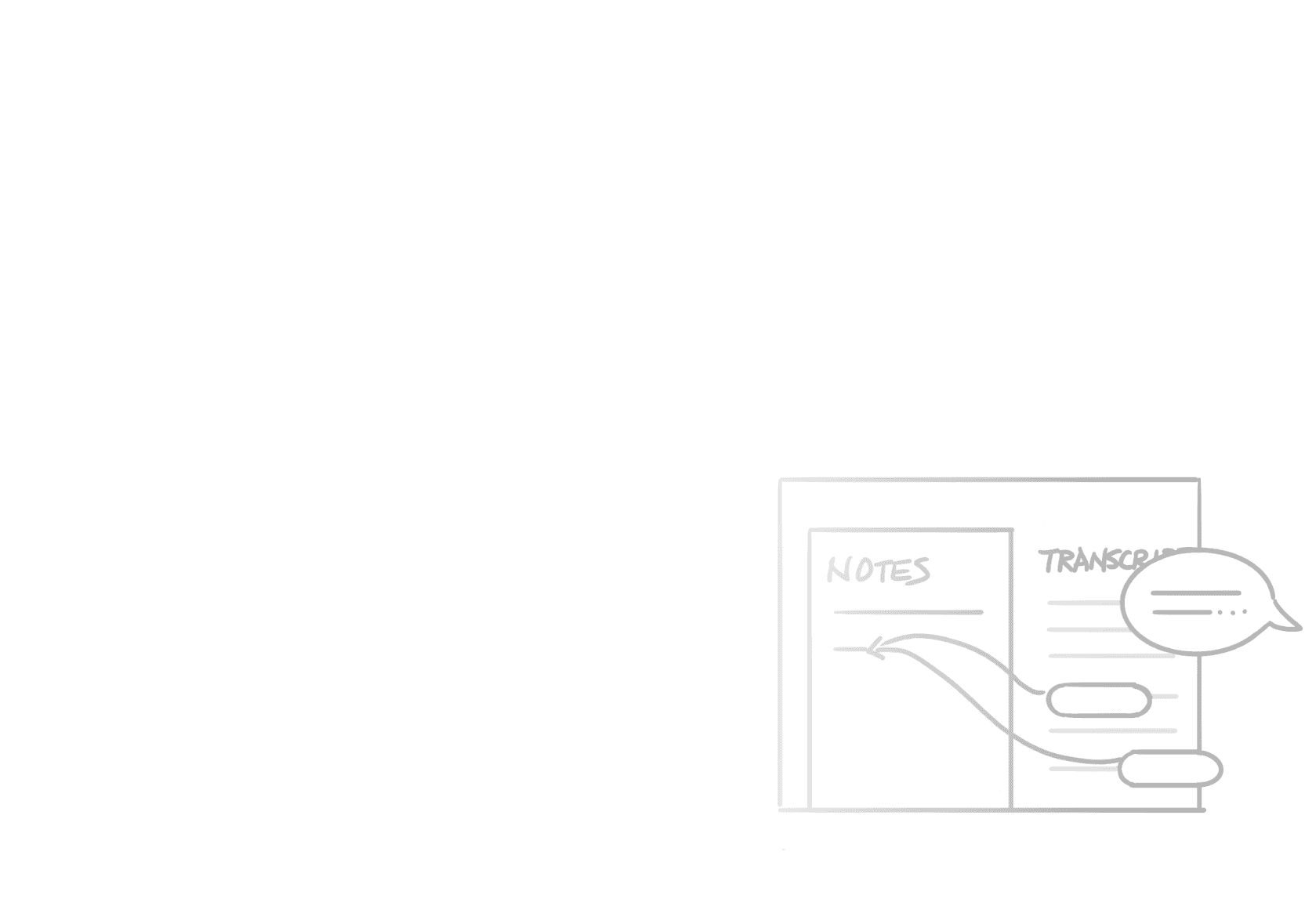
3
Gaining traction by pitching use cases
I pitched AI-driven solutions such as speech-to-text and generative AI tools for patient surveys. These practical AI use cases reduced clinician workload, secured early stakeholder buy-in, and showed how AI could align with Verily’s strategic goals.
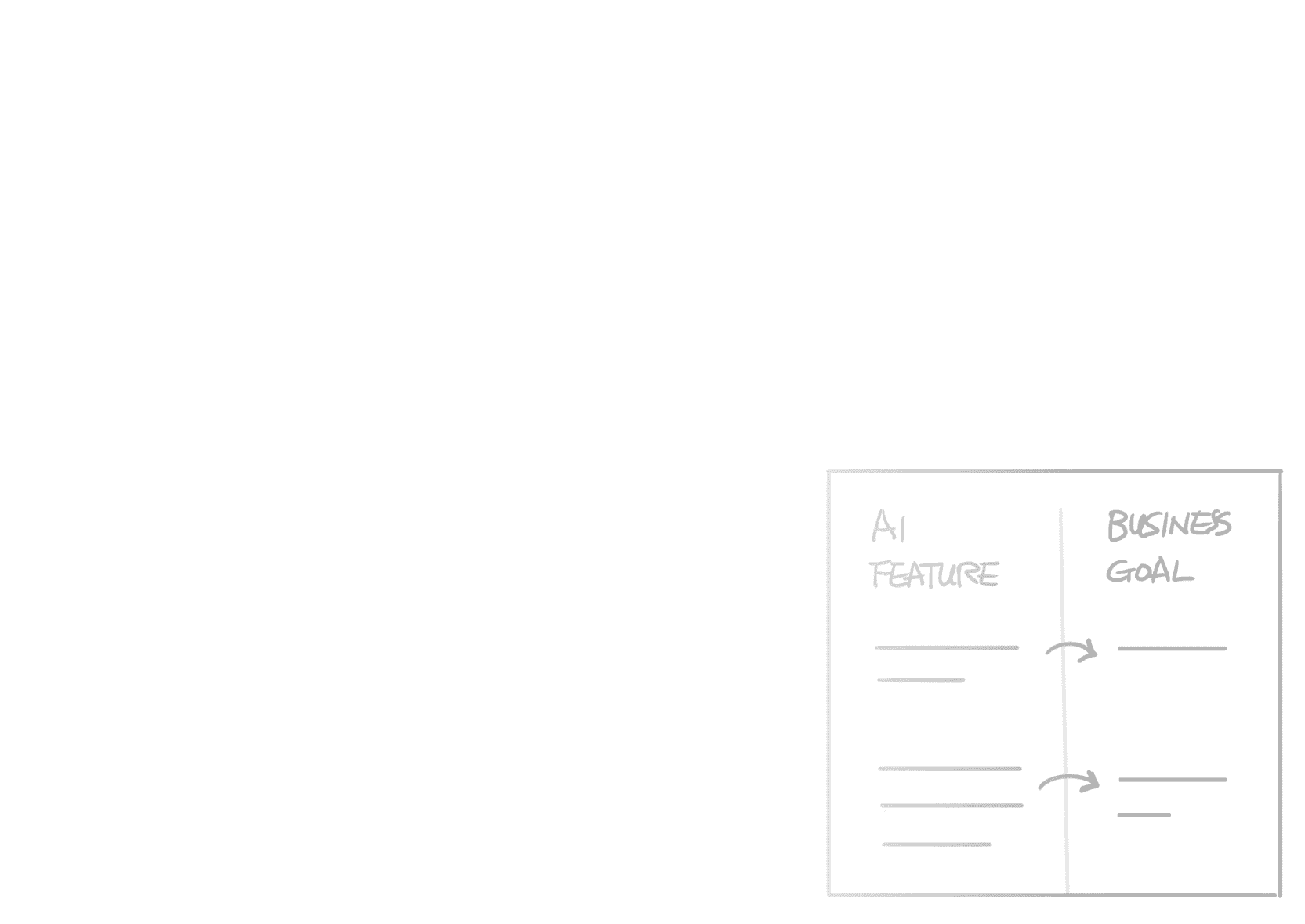
4
Strategy workshop with champions
In a strategy workshop, I aligned data science, product, and engineering teams on AI’s role in Verily’s product roadmap. Through data science team demos and prototypes, I addressed concerns from skeptics, moving AI-driven tools onto both clinician and patient product roadmaps.
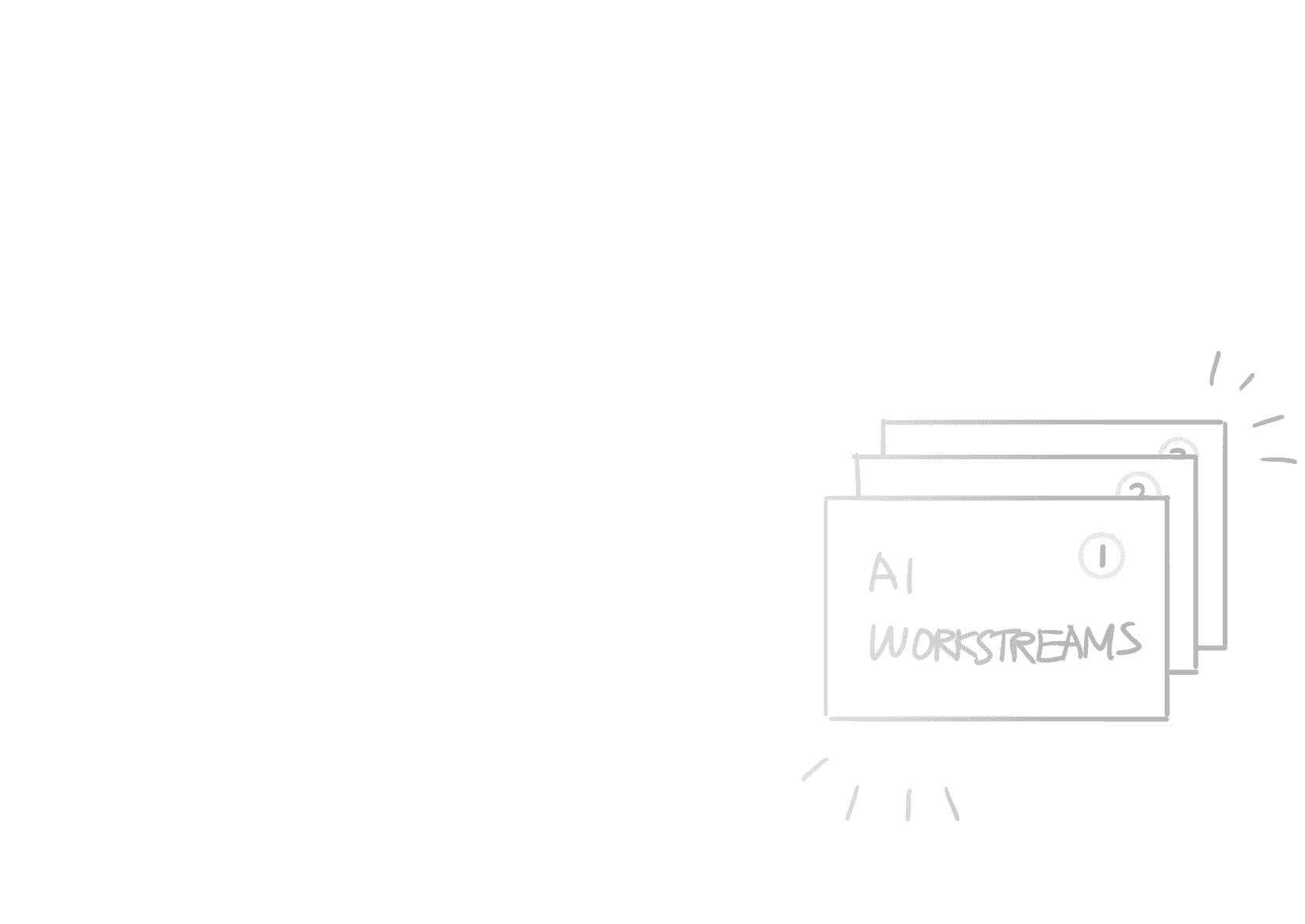
5
Securing leadership buy-in for AI
After presenting AI’s potential for clinical workflow efficiency and accuracy, secured leadership approval to embed AI-driven workstreams into Verily’s clinical products. This led to AI becoming a cornerstone of Verily’s future care strategy.
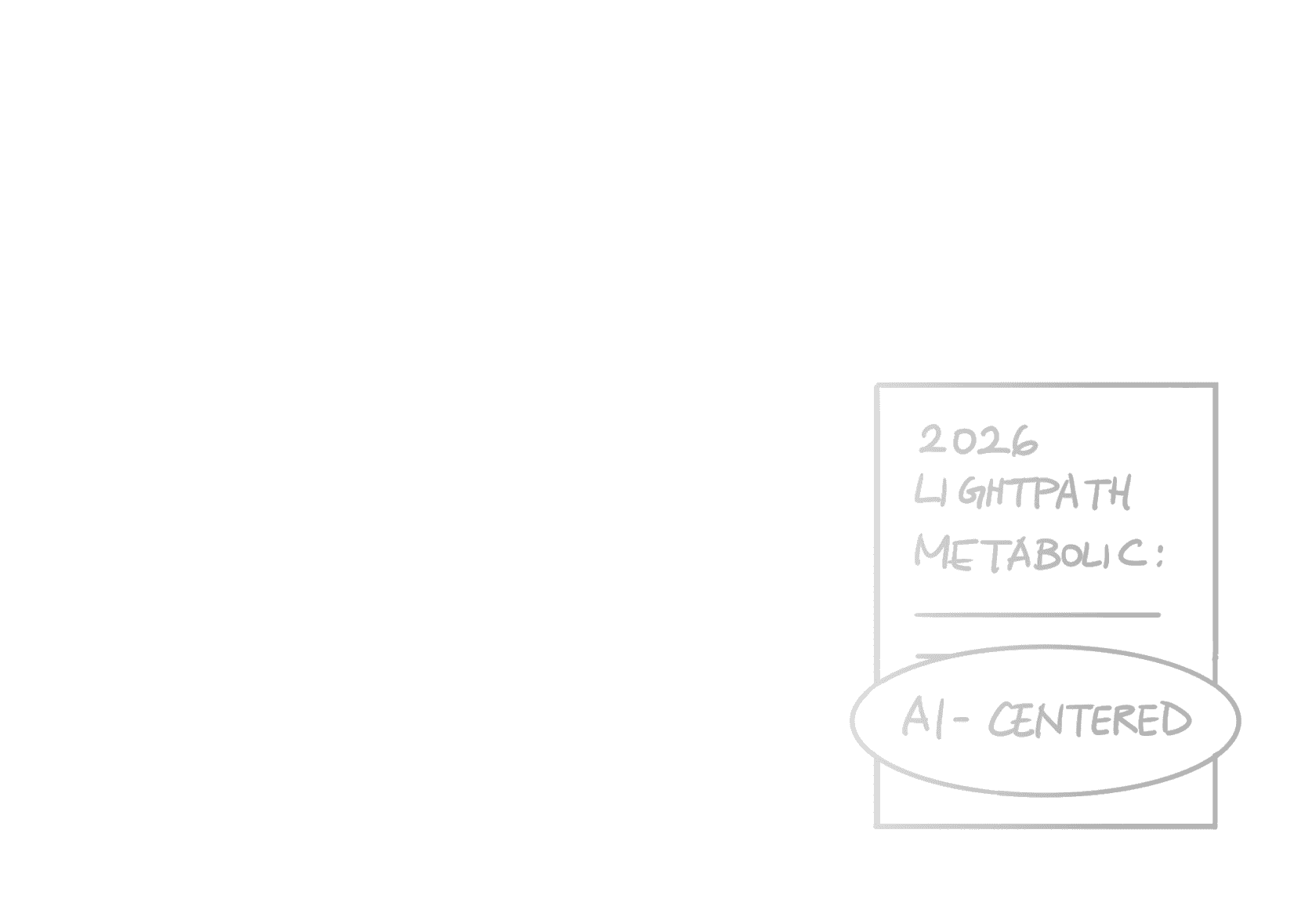
6
Outcome: AI key part of 2026 strategy
AI became central to Verily’s 2026 care strategy, driving clinical efficiency and scalability, and positioning Verily as a market leader. The Chief Product Officer recognized AI as a key differentiator, securing its role in future product developments.

1
Overcoming resistance to AI
Leadership and clinical teams initially resisted AI, seeing it as irrelevant for healthcare. I had to prove its potential for improving workflows and aligning it with business goals.

2
Workshops to build vision
I led a cross-functional workshop with UX, engineering, and data science teams, showcasing AI-driven tools to improve clinical documentation and summarization. This workshop unified the team around AI’s potential to enhance clinician efficiency.

3
Gaining traction by pitching use cases
I pitched AI-driven solutions such as speech-to-text and generative AI tools for patient surveys. These practical AI use cases reduced clinician workload, secured early stakeholder buy-in, and showed how AI could align with Verily’s strategic goals.

4
Strategy workshop with champions
In a strategy workshop, I aligned data science, product, and engineering teams on AI’s role in Verily’s product roadmap. Through data science team demos and prototypes, I addressed concerns from skeptics, moving AI-driven tools onto both clinician and patient product roadmaps.

5
Securing leadership buy-in for AI
After presenting AI’s potential for clinical workflow efficiency and accuracy, secured leadership approval to embed AI-driven workstreams into Verily’s clinical products. This led to AI becoming a cornerstone of Verily’s future care strategy.

6
Outcome: AI key part of 2026 strategy
AI became central to Verily’s 2026 care strategy, driving clinical efficiency and scalability, and positioning Verily as a market leader. The Chief Product Officer recognized AI as a key differentiator, securing its role in future product developments.

1
Overcoming resistance to AI
Leadership and clinical teams initially resisted AI, seeing it as irrelevant for healthcare. I had to prove its potential for improving workflows and aligning it with business goals.

2
Workshops to build vision
I led a cross-functional workshop with UX, engineering, and data science teams, showcasing AI-driven tools to improve clinical documentation and summarization. This workshop unified the team around AI’s potential to enhance clinician efficiency.

3
Gaining traction by pitching use cases
I pitched AI-driven solutions such as speech-to-text and generative AI tools for patient surveys. These practical AI use cases reduced clinician workload, secured early stakeholder buy-in, and showed how AI could align with Verily’s strategic goals.

4
Strategy workshop with champions
In a strategy workshop, I aligned data science, product, and engineering teams on AI’s role in Verily’s product roadmap. Through data science team demos and prototypes, I addressed concerns from skeptics, moving AI-driven tools onto both clinician and patient product roadmaps.

5
Securing leadership buy-in for AI
After presenting AI’s potential for clinical workflow efficiency and accuracy, secured leadership approval to embed AI-driven workstreams into Verily’s clinical products. This led to AI becoming a cornerstone of Verily’s future care strategy.

6
Outcome: AI key part of 2026 strategy
AI became central to Verily’s 2026 care strategy, driving clinical efficiency and scalability, and positioning Verily as a market leader. The Chief Product Officer recognized AI as a key differentiator, securing its role in future product developments.

1
Overcoming resistance to AI
Leadership and clinical teams initially resisted AI, seeing it as irrelevant for healthcare. I had to prove its potential for improving workflows and aligning it with business goals.

2
Workshops to build vision
I led a cross-functional workshop with UX, engineering, and data science teams, showcasing AI-driven tools to improve clinical documentation and summarization. This workshop unified the team around AI’s potential to enhance clinician efficiency.

3
Gaining traction by pitching use cases
I pitched AI-driven solutions such as speech-to-text and generative AI tools for patient surveys. These practical AI use cases reduced clinician workload, secured early stakeholder buy-in, and showed how AI could align with Verily’s strategic goals.

4
Strategy workshop with champions
In a strategy workshop, I aligned data science, product, and engineering teams on AI’s role in Verily’s product roadmap. Through data science team demos and prototypes, I addressed concerns from skeptics, moving AI-driven tools onto both clinician and patient product roadmaps.

5
Securing leadership buy-in for AI
After presenting AI’s potential for clinical workflow efficiency and accuracy, secured leadership approval to embed AI-driven workstreams into Verily’s clinical products. This led to AI becoming a cornerstone of Verily’s future care strategy.

6
Outcome: AI key part of 2026 strategy
AI became central to Verily’s 2026 care strategy, driving clinical efficiency and scalability, and positioning Verily as a market leader. The Chief Product Officer recognized AI as a key differentiator, securing its role in future product developments.

1
Overcoming resistance to AI
Leadership and clinical teams initially resisted AI, seeing it as irrelevant for healthcare. I had to prove its potential for improving workflows and aligning it with business goals.

2
Cross-functional workshops to build AI product vision
I led a cross-functional workshop with UX, engineering, and data science teams, showcasing AI-driven tools to improve clinical documentation and summarization. This workshop unified the team around AI’s potential to enhance clinician efficiency.
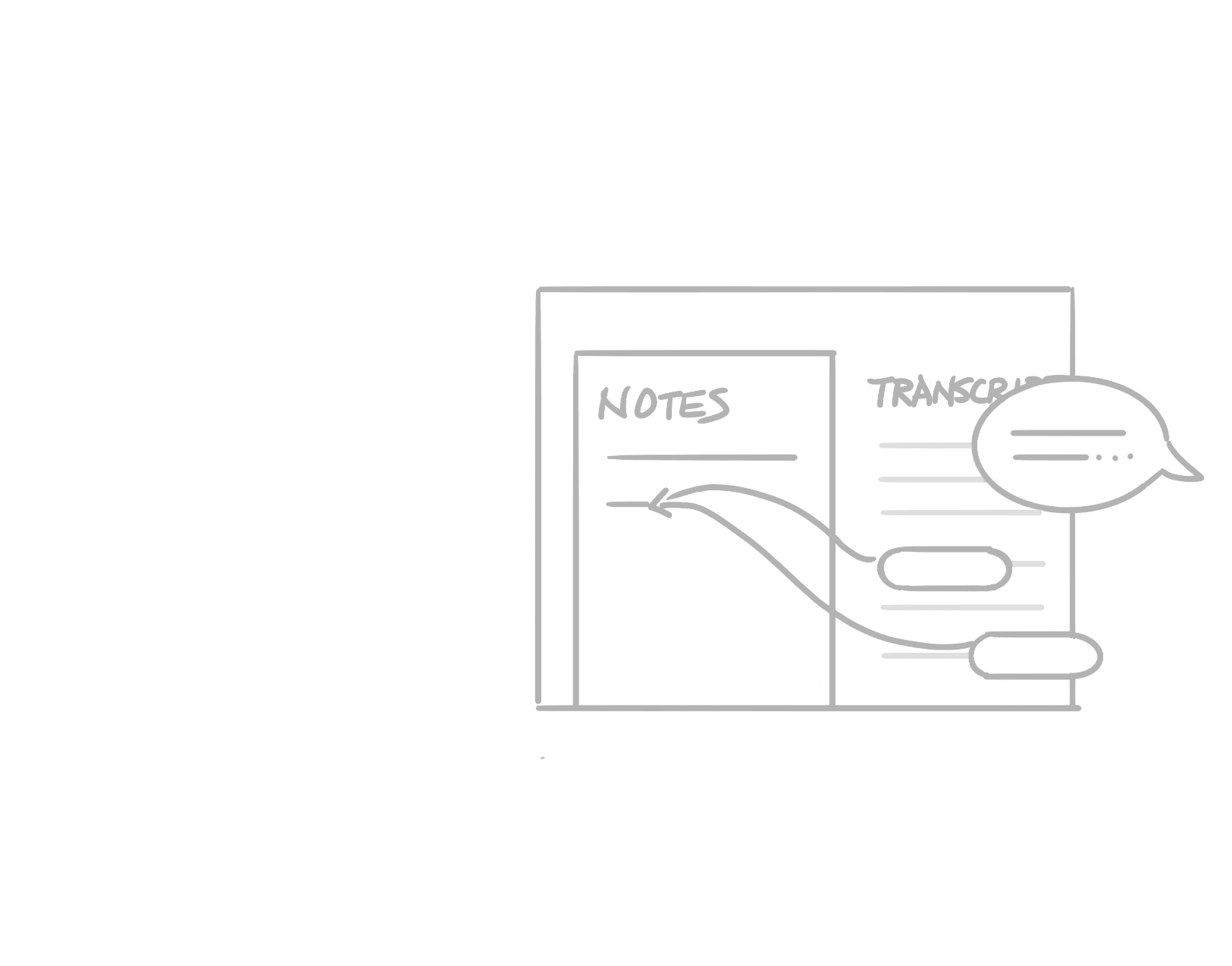
3
Gaining traction by pitching use cases
I pitched AI-driven solutions such as speech-to-text and generative AI tools for patient surveys. These practical AI use cases reduced clinician workload, secured early stakeholder buy-in, and showed how AI could align with Verily’s strategic goals.
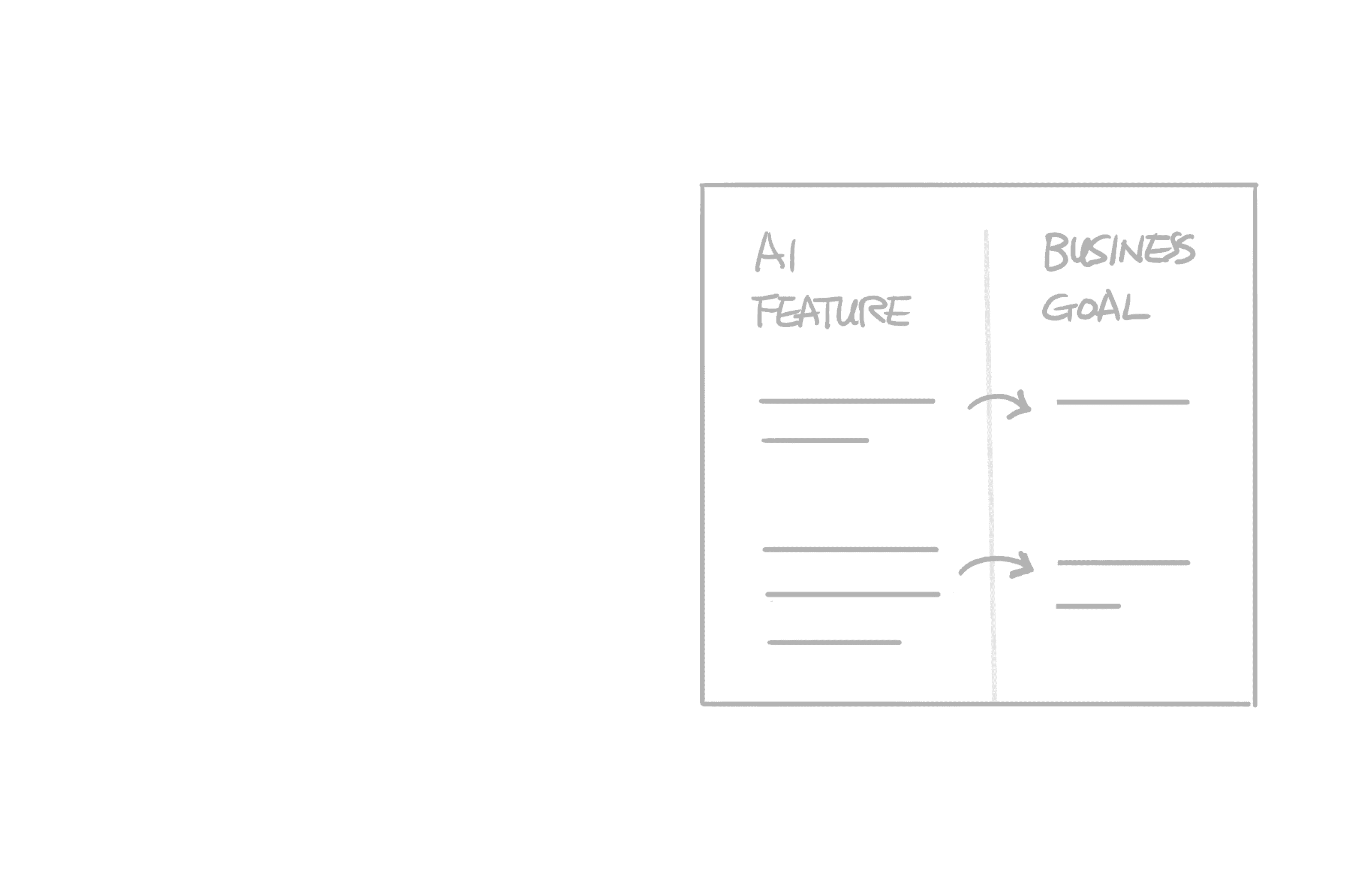
4
Strategy workshop with champions
In a strategy workshop, I aligned data science, product, and engineering teams on AI’s role in Verily’s product roadmap. Through data science team demos and prototypes, I addressed concerns from skeptics, moving AI-driven tools onto both clinician and patient product roadmaps.
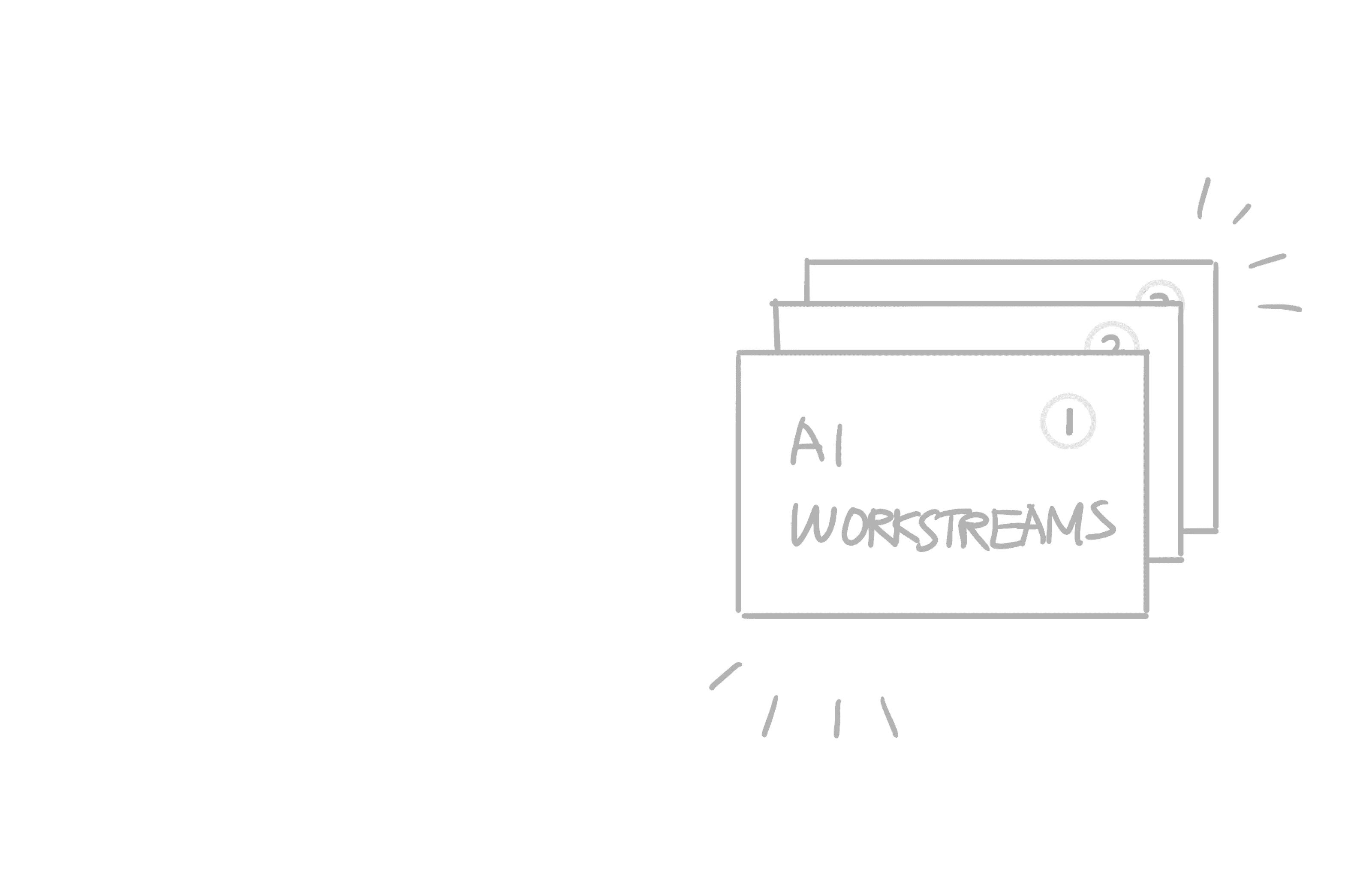
5
Securing leadership buy-in for AI
After presenting AI’s potential for clinical workflow efficiency and accuracy, secured leadership approval to embed AI-driven workstreams into Verily’s clinical products. This led to AI becoming a cornerstone of Verily’s future care strategy.
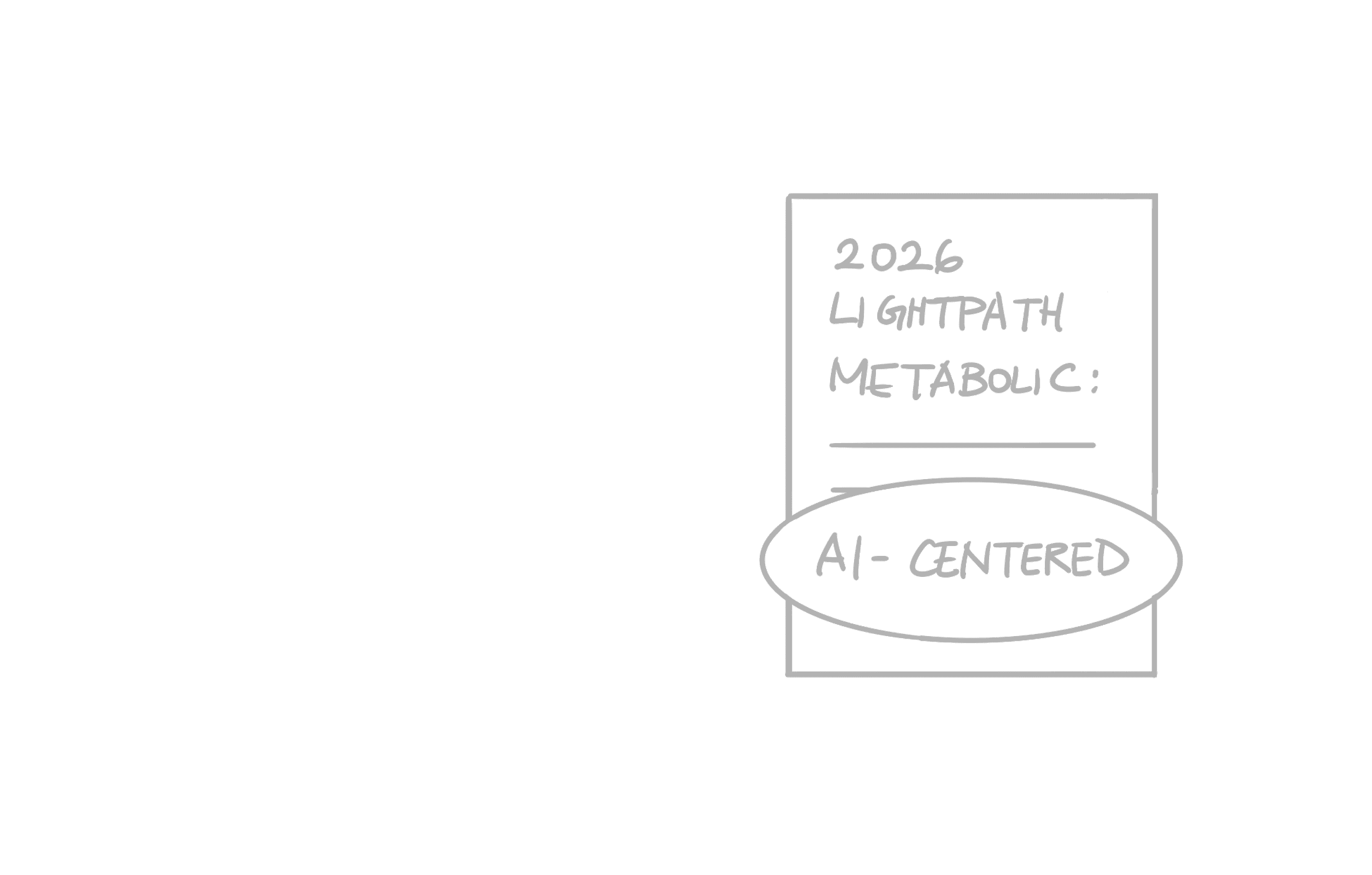
6
Outcome: AI embedded in Verily’s 2026 strategy
AI became central to Verily’s 2026 care strategy, driving clinical efficiency and scalability, and positioning Verily as a market leader. The Chief Product Officer recognized AI as a key differentiator, securing its role in future product developments.

1
Overcoming resistance to AI
Leadership and clinical teams initially resisted AI, seeing it as irrelevant for healthcare. I had to prove its potential for improving workflows and aligning it with business goals.

2
Cross-functional workshops to build AI product vision
I led a cross-functional workshop with UX, engineering, and data science teams, showcasing AI-driven tools to improve clinical documentation and summarization. This workshop unified the team around AI’s potential to enhance clinician efficiency.

3
Gaining traction by pitching use cases
I pitched AI-driven solutions such as speech-to-text and generative AI tools for patient surveys. These practical AI use cases reduced clinician workload, secured early stakeholder buy-in, and showed how AI could align with Verily’s strategic goals.

4
Strategy workshop with champions
In a strategy workshop, I aligned data science, product, and engineering teams on AI’s role in Verily’s product roadmap. Through data science team demos and prototypes, I addressed concerns from skeptics, moving AI-driven tools onto both clinician and patient product roadmaps.

5
Securing leadership buy-in for AI
After presenting AI’s potential for clinical workflow efficiency and accuracy, secured leadership approval to embed AI-driven workstreams into Verily’s clinical products. This led to AI becoming a cornerstone of Verily’s future care strategy.

6
Outcome: AI embedded in Verily’s 2026 strategy
AI became central to Verily’s 2026 care strategy, driving clinical efficiency and scalability, and positioning Verily as a market leader. The Chief Product Officer recognized AI as a key differentiator, securing its role in future product developments.

1
Overcoming resistance to AI
Leadership and clinical teams initially resisted AI, seeing it as irrelevant for healthcare. I had to prove its potential for improving workflows and aligning it with business goals.

2
Cross-functional workshops to build AI product vision
I led a cross-functional workshop with UX, engineering, and data science teams, showcasing AI-driven tools to improve clinical documentation and summarization. This workshop unified the team around AI’s potential to enhance clinician efficiency.

3
Gaining traction by pitching use cases
I pitched AI-driven solutions such as speech-to-text and generative AI tools for patient surveys. These practical AI use cases reduced clinician workload, secured early stakeholder buy-in, and showed how AI could align with Verily’s strategic goals.

4
Strategy workshop with champions
In a strategy workshop, I aligned data science, product, and engineering teams on AI’s role in Verily’s product roadmap. Through data science team demos and prototypes, I addressed concerns from skeptics, moving AI-driven tools onto both clinician and patient product roadmaps.

5
Securing leadership buy-in for AI
After presenting AI’s potential for clinical workflow efficiency and accuracy, secured leadership approval to embed AI-driven workstreams into Verily’s clinical products. This led to AI becoming a cornerstone of Verily’s future care strategy.

6
Outcome: AI embedded in Verily’s 2026 strategy
AI became central to Verily’s 2026 care strategy, driving clinical efficiency and scalability, and positioning Verily as a market leader. The Chief Product Officer recognized AI as a key differentiator, securing its role in future product developments.

1
Overcoming resistance to AI
Leadership and clinical teams initially resisted AI, seeing it as irrelevant for healthcare. I had to prove its potential for improving workflows and aligning it with business goals.

2
Cross-functional workshops to build AI product vision
I led a cross-functional workshop with UX, engineering, and data science teams, showcasing AI-driven tools to improve clinical documentation and summarization. This workshop unified the team around AI’s potential to enhance clinician efficiency.

3
Gaining traction by pitching use cases
I pitched AI-driven solutions such as speech-to-text and generative AI tools for patient surveys. These practical AI use cases reduced clinician workload, secured early stakeholder buy-in, and showed how AI could align with Verily’s strategic goals.

4
Strategy workshop with champions
In a strategy workshop, I aligned data science, product, and engineering teams on AI’s role in Verily’s product roadmap. Through data science team demos and prototypes, I addressed concerns from skeptics, moving AI-driven tools onto both clinician and patient product roadmaps.

5
Securing leadership buy-in for AI
After presenting AI’s potential for clinical workflow efficiency and accuracy, secured leadership approval to embed AI-driven workstreams into Verily’s clinical products. This led to AI becoming a cornerstone of Verily’s future care strategy.

6
Outcome: AI embedded in Verily’s 2026 strategy
AI became central to Verily’s 2026 care strategy, driving clinical efficiency and scalability, and positioning Verily as a market leader. The Chief Product Officer recognized AI as a key differentiator, securing its role in future product developments.

1
Overcoming resistance to AI
Leadership and clinical teams initially resisted AI, seeing it as irrelevant for healthcare. I had to prove its potential for improving workflows and aligning it with business goals.

2
Cross-functional workshops to build AI product vision
I led a cross-functional workshop with UX, engineering, and data science teams, showcasing AI-driven tools to improve clinical documentation and summarization. This workshop unified the team around AI’s potential to enhance clinician efficiency.

3
Gaining traction by pitching use cases
I pitched AI-driven solutions such as speech-to-text and generative AI tools for patient surveys. These practical AI use cases reduced clinician workload, secured early stakeholder buy-in, and showed how AI could align with Verily’s strategic goals.

4
Strategy workshop with champions
In a strategy workshop, I aligned data science, product, and engineering teams on AI’s role in Verily’s product roadmap. Through data science team demos and prototypes, I addressed concerns from skeptics, moving AI-driven tools onto both clinician and patient product roadmaps.

5
Securing leadership buy-in for AI
After presenting AI’s potential for clinical workflow efficiency and accuracy, secured leadership approval to embed AI-driven workstreams into Verily’s clinical products. This led to AI becoming a cornerstone of Verily’s future care strategy.

6
Outcome: AI embedded in Verily’s 2026 strategy
AI became central to Verily’s 2026 care strategy, driving clinical efficiency and scalability, and positioning Verily as a market leader. The Chief Product Officer recognized AI as a key differentiator, securing its role in future product developments.

1
Overcoming resistance to AI
Leadership and clinical teams initially resisted AI, seeing it as irrelevant for healthcare. I had to prove its potential for improving workflows and aligning it with business goals.

2
Cross-functional workshops to build AI product vision
I led a cross-functional workshop with UX, engineering, and data science teams, showcasing AI-driven tools to improve clinical documentation and summarization. This workshop unified the team around AI’s potential to enhance clinician efficiency.

3
Gaining traction by pitching use cases
I pitched AI-driven solutions such as speech-to-text and generative AI tools for patient surveys. These practical AI use cases reduced clinician workload, secured early stakeholder buy-in, and showed how AI could align with Verily’s strategic goals.

4
Strategy workshop with champions
In a strategy workshop, I aligned data science, product, and engineering teams on AI’s role in Verily’s product roadmap. Through data science team demos and prototypes, I addressed concerns from skeptics, moving AI-driven tools onto both clinician and patient product roadmaps.

5
Securing leadership buy-in for AI
After presenting AI’s potential for clinical workflow efficiency and accuracy, secured leadership approval to embed AI-driven workstreams into Verily’s clinical products. This led to AI becoming a cornerstone of Verily’s future care strategy.

6
Outcome: AI embedded in Verily’s 2026 strategy
AI became central to Verily’s 2026 care strategy, driving clinical efficiency and scalability, and positioning Verily as a market leader. The Chief Product Officer recognized AI as a key differentiator, securing its role in future product developments.

1
Overcoming resistance to AI
Leadership and clinical teams initially resisted AI, seeing it as irrelevant for healthcare. I had to prove its potential for improving workflows and aligning it with business goals.

2
Cross-functional workshops to build AI product vision
I led a cross-functional workshop with UX, engineering, and data science teams, showcasing AI-driven tools to improve clinical documentation and summarization. This workshop unified the team around AI’s potential to enhance clinician efficiency.

3
Gaining traction by pitching use cases
I pitched AI-driven solutions such as speech-to-text and generative AI tools for patient surveys. These practical AI use cases reduced clinician workload, secured early stakeholder buy-in, and showed how AI could align with Verily’s strategic goals.

4
Strategy workshop with champions
In a strategy workshop, I aligned data science, product, and engineering teams on AI’s role in Verily’s product roadmap. Through data science team demos and prototypes, I addressed concerns from skeptics, moving AI-driven tools onto both clinician and patient product roadmaps.

5
Securing leadership buy-in for AI
After presenting AI’s potential for clinical workflow efficiency and accuracy, secured leadership approval to embed AI-driven workstreams into Verily’s clinical products. This led to AI becoming a cornerstone of Verily’s future care strategy.

6
Outcome: AI embedded in Verily’s 2026 strategy
AI became central to Verily’s 2026 care strategy, driving clinical efficiency and scalability, and positioning Verily as a market leader. The Chief Product Officer recognized AI as a key differentiator, securing its role in future product developments.

1
Overcoming resistance to AI
Leadership and clinical teams initially resisted AI, seeing it as irrelevant for healthcare. I had to prove its potential for improving workflows and aligning it with business goals.

2
Cross-functional workshops to build AI product vision
I led a cross-functional workshop with UX, engineering, and data science teams, showcasing AI-driven tools to improve clinical documentation and summarization. This workshop unified the team around AI’s potential to enhance clinician efficiency.

3
Gaining traction by pitching use cases
I pitched AI-driven solutions such as speech-to-text and generative AI tools for patient surveys. These practical AI use cases reduced clinician workload, secured early stakeholder buy-in, and showed how AI could align with Verily’s strategic goals.

4
Strategy workshop with champions
In a strategy workshop, I aligned data science, product, and engineering teams on AI’s role in Verily’s product roadmap. Through data science team demos and prototypes, I addressed concerns from skeptics, moving AI-driven tools onto both clinician and patient product roadmaps.

5
Securing leadership buy-in for AI
After presenting AI’s potential for clinical workflow efficiency and accuracy, secured leadership approval to embed AI-driven workstreams into Verily’s clinical products. This led to AI becoming a cornerstone of Verily’s future care strategy.

6
Outcome: AI embedded in Verily’s 2026 strategy
AI became central to Verily’s 2026 care strategy, driving clinical efficiency and scalability, and positioning Verily as a market leader. The Chief Product Officer recognized AI as a key differentiator, securing its role in future product developments.

1
Overcoming resistance to AI
Leadership and clinical teams initially resisted AI, seeing it as irrelevant for healthcare. I had to prove its potential for improving workflows and aligning it with business goals.

2
Cross-functional workshops build AI product vision
I led a cross-functional workshop with UX, engineering, and data science teams, showcasing AI-driven tools to improve clinical documentation and summarization. This workshop unified the team around AI’s potential to enhance clinician efficiency.

3
Gaining traction by pitching key AI use cases
I pitched AI-driven solutions such as speech-to-text and generative AI tools for patient surveys. These practical AI use cases reduced clinician workload, secured early stakeholder buy-in, and showed how AI could align with Verily’s strategic goals.

4
AI strategy workshop with key champions
In a strategy workshop, I aligned data science, product, and engineering teams on AI’s role in Verily’s product roadmap. Through data science team demos and prototypes, I addressed concerns from skeptics, moving AI-driven tools onto both clinician and patient product roadmaps.

5
Securing leadership buy-in for AI
After presenting AI’s potential for clinical efficiency, scalability, and decision support, I secured leadership approval to embed AI-driven workstreams into Verily’s clinical products. This led to AI becoming a cornerstone of Verily’s long-term care strategy.

6
Outcome: AI embedded in Verily’s 2026 strategy
AI became central to Verily’s 2026 care strategy, driving clinical efficiency and scalability, and positioning Verily as a market leader. The Chief Product Officer recognized AI as a key differentiator, securing its role in future product developments.

1
Overcoming resistance to AI
Leadership and clinical teams initially resisted AI, seeing it as irrelevant for healthcare. I had to prove its potential for improving workflows and aligning it with business goals.

2
Cross-functional workshops build AI product vision
I led a cross-functional workshop with UX, engineering, and data science teams, showcasing AI-driven tools to improve clinical documentation and summarization. This workshop unified the team around AI’s potential to enhance clinician efficiency.

3
Gaining traction by pitching key AI use cases
I pitched AI-driven solutions such as speech-to-text and generative AI tools for patient surveys. These practical AI use cases reduced clinician workload, secured early stakeholder buy-in, and showed how AI could align with Verily’s strategic goals.

4
AI strategy workshop with key champions
In a strategy workshop, I aligned data science, product, and engineering teams on AI’s role in Verily’s product roadmap. Through data science team demos and prototypes, I addressed concerns from skeptics, moving AI-driven tools onto both clinician and patient product roadmaps.

5
Securing leadership buy-in for AI
After presenting AI’s potential for clinical efficiency, scalability, and decision support, I secured leadership approval to embed AI-driven workstreams into Verily’s clinical products. This led to AI becoming a cornerstone of Verily’s long-term care strategy.

6
Outcome: AI embedded in Verily’s 2026 strategy
AI became central to Verily’s 2026 care strategy, driving clinical efficiency and scalability, and positioning Verily as a market leader. The Chief Product Officer recognized AI as a key differentiator, securing its role in future product developments.

1
Overcoming resistance to AI
Leadership and clinical teams initially resisted AI, seeing it as irrelevant for healthcare. I had to prove its potential for improving workflows and aligning it with business goals.

2
Cross-functional workshops build AI product vision
I led a cross-functional workshop with UX, engineering, and data science teams, showcasing AI-driven tools to improve clinical documentation and summarization. This workshop unified the team around AI’s potential to enhance clinician efficiency.

3
Gaining traction by pitching key AI use cases
I pitched AI-driven solutions such as speech-to-text and generative AI tools for patient surveys. These practical AI use cases reduced clinician workload, secured early stakeholder buy-in, and showed how AI could align with Verily’s strategic goals.

4
AI strategy workshop with key champions
In a strategy workshop, I aligned data science, product, and engineering teams on AI’s role in Verily’s product roadmap. Through data science team demos and prototypes, I addressed concerns from skeptics, moving AI-driven tools onto both clinician and patient product roadmaps.

5
Securing leadership buy-in for AI
After presenting AI’s potential for clinical efficiency, scalability, and decision support, I secured leadership approval to embed AI-driven workstreams into Verily’s clinical products. This led to AI becoming a cornerstone of Verily’s long-term care strategy.

6
Outcome: AI embedded in Verily’s 2026 strategy
AI became central to Verily’s 2026 care strategy, driving clinical efficiency and scalability, and positioning Verily as a market leader. The Chief Product Officer recognized AI as a key differentiator, securing its role in future product developments.

1
Overcoming resistance to AI
Leadership and clinical teams initially resisted AI, seeing it as irrelevant for healthcare. I had to prove its potential for improving workflows and aligning it with business goals.

2
Cross-functional workshops build AI product vision
I led a cross-functional workshop with UX, engineering, and data science teams, showcasing AI-driven tools to improve clinical documentation and summarization. This workshop unified the team around AI’s potential to enhance clinician efficiency.

3
Gaining traction by pitching key AI use cases
I pitched AI-driven solutions such as speech-to-text and generative AI tools for patient surveys. These practical AI use cases reduced clinician workload, secured early stakeholder buy-in, and showed how AI could align with Verily’s strategic goals.

4
AI strategy workshop with key champions
In a strategy workshop, I aligned data science, product, and engineering teams on AI’s role in Verily’s product roadmap. Through data science team demos and prototypes, I addressed concerns from skeptics, moving AI-driven tools onto both clinician and patient product roadmaps.

5
Securing leadership buy-in for AI
After presenting AI’s potential for clinical efficiency, scalability, and decision support, I secured leadership approval to embed AI-driven workstreams into Verily’s clinical products. This led to AI becoming a cornerstone of Verily’s long-term care strategy.

6
Outcome: AI embedded in Verily’s 2026 strategy
AI became central to Verily’s 2026 care strategy, driving clinical efficiency and scalability, and positioning Verily as a market leader. The Chief Product Officer recognized AI as a key differentiator, securing its role in future product developments.

1
Overcoming resistance to AI
Leadership and clinical teams initially resisted AI, seeing it as irrelevant for healthcare. I had to prove its potential for improving workflows and aligning it with business goals.

2
Cross-functional workshops to build AI product vision
I led a cross-functional workshop with UX, engineering, and data science teams, showcasing AI-driven tools to improve clinical documentation and summarization. This workshop unified the team around AI’s potential to enhance clinician efficiency.

3
Gaining traction by pitching key AI use cases
I pitched AI-driven solutions such as speech-to-text and generative AI tools for patient surveys. These practical AI use cases reduced clinician workload, secured early stakeholder buy-in, and showed how AI could align with Verily’s strategic goals.

4
AI strategy workshop with key champions
In a strategy workshop, I aligned data science, product, and engineering teams on AI’s role in Verily’s product roadmap. Through data science team demos and prototypes, I addressed concerns from skeptics, moving AI-driven tools onto both clinician and patient product roadmaps.

5
Securing leadership buy-in for AI
After presenting AI’s potential for clinical workflow efficiency and accuracy, secured leadership approval to embed AI-driven workstreams into Verily’s clinical products. This led to AI becoming a cornerstone of Verily’s future care strategy.

6
Outcome: AI embedded in Verily’s 2026 strategy
AI became central to Verily’s 2026 care strategy, driving clinical efficiency and scalability, and positioning Verily as a market leader. The Chief Product Officer recognized AI as a key differentiator, securing its role in future product developments.

1
Overcoming resistance to AI
Leadership and clinical teams initially resisted AI, seeing it as irrelevant for healthcare. I had to prove its potential for improving workflows and aligning it with business goals.

2
Cross-functional workshops to build AI product vision
I led a cross-functional workshop with UX, engineering, and data science teams, showcasing AI-driven tools to improve clinical documentation and summarization. This workshop unified the team around AI’s potential to enhance clinician efficiency.

3
Gaining traction by pitching key AI use cases
I pitched AI-driven solutions such as speech-to-text and generative AI tools for patient surveys. These practical AI use cases reduced clinician workload, secured early stakeholder buy-in, and showed how AI could align with Verily’s strategic goals.

4
AI strategy workshop with key champions
In a strategy workshop, I aligned data science, product, and engineering teams on AI’s role in Verily’s product roadmap. Through data science team demos and prototypes, I addressed concerns from skeptics, moving AI-driven tools onto both clinician and patient product roadmaps.

5
Securing leadership buy-in for AI
After presenting AI’s potential for clinical workflow efficiency and accuracy, secured leadership approval to embed AI-driven workstreams into Verily’s clinical products. This led to AI becoming a cornerstone of Verily’s future care strategy.

6
Outcome: AI embedded in Verily’s 2026 strategy
AI became central to Verily’s 2026 care strategy, driving clinical efficiency and scalability, and positioning Verily as a market leader. The Chief Product Officer recognized AI as a key differentiator, securing its role in future product developments.

1
Overcoming resistance to AI
Leadership and clinical teams initially resisted AI, seeing it as irrelevant for healthcare. I had to prove its potential for improving workflows and aligning it with business goals.

2
Cross-functional workshops to build AI product vision
I led a cross-functional workshop with UX, engineering, and data science teams, showcasing AI-driven tools to improve clinical documentation and summarization. This workshop unified the team around AI’s potential to enhance clinician efficiency.

3
Gaining traction by pitching key AI use cases
I pitched AI-driven solutions such as speech-to-text and generative AI tools for patient surveys. These practical AI use cases reduced clinician workload, secured early stakeholder buy-in, and showed how AI could align with Verily’s strategic goals.

4
AI strategy workshop with key champions
In a strategy workshop, I aligned data science, product, and engineering teams on AI’s role in Verily’s product roadmap. Through data science team demos and prototypes, I addressed concerns from skeptics, moving AI-driven tools onto both clinician and patient product roadmaps.

5
Securing leadership buy-in for AI
After presenting AI’s potential for clinical workflow efficiency and accuracy, secured leadership approval to embed AI-driven workstreams into Verily’s clinical products. This led to AI becoming a cornerstone of Verily’s future care strategy.

6
Outcome: AI embedded in Verily’s 2026 strategy
AI became central to Verily’s 2026 care strategy, driving clinical efficiency and scalability, and positioning Verily as a market leader. The Chief Product Officer recognized AI as a key differentiator, securing its role in future product developments.

1
Overcoming resistance to AI
Leadership and clinical teams initially resisted AI, seeing it as irrelevant for healthcare. I had to prove its potential for improving workflows and aligning it with business goals.

2
Cross-functional workshops to build AI product vision
I led a cross-functional workshop with UX, engineering, and data science teams, showcasing AI-driven tools to improve clinical documentation and summarization. This workshop unified the team around AI’s potential to enhance clinician efficiency.

3
Gaining traction by pitching key AI use cases
I pitched AI-driven solutions such as speech-to-text and generative AI tools for patient surveys. These practical AI use cases reduced clinician workload, secured early stakeholder buy-in, and showed how AI could align with Verily’s strategic goals.

4
AI strategy workshop with key champions
In a strategy workshop, I aligned data science, product, and engineering teams on AI’s role in Verily’s product roadmap. Through data science team demos and prototypes, I addressed concerns from skeptics, moving AI-driven tools onto both clinician and patient product roadmaps.

5
Securing leadership buy-in for AI
After presenting AI’s potential for clinical workflow efficiency and accuracy, secured leadership approval to embed AI-driven workstreams into Verily’s clinical products. This led to AI becoming a cornerstone of Verily’s future care strategy.

6
Outcome: AI embedded in Verily’s 2026 strategy
AI became central to Verily’s 2026 care strategy, driving clinical efficiency and scalability, and positioning Verily as a market leader. The Chief Product Officer recognized AI as a key differentiator, securing its role in future product developments.


1
Overcoming resistance to AI
Leadership and clinical teams initially resisted AI, seeing it as irrelevant for healthcare. I had to prove its potential for improving workflows and aligning it with business goals.

2
Workshops to build vision
I led a cross-functional workshop with UX, engineering, and data science teams, showcasing AI-driven tools to improve clinical documentation and summarization. This workshop unified the team around AI’s potential to enhance clinician efficiency.

3
Gaining traction by pitching use cases
I pitched AI-driven solutions such as speech-to-text and generative AI tools for patient surveys. These practical AI use cases reduced clinician workload, secured early stakeholder buy-in, and showed how AI could align with Verily’s strategic goals.

4
Strategy workshop with champions
In a strategy workshop, I aligned data science, product, and engineering teams on AI’s role in Verily’s product roadmap. Through data science team demos and prototypes, I addressed concerns from skeptics, moving AI-driven tools onto both clinician and patient product roadmaps.

5
Securing leadership buy-in for AI
After presenting AI’s potential for clinical workflow efficiency and accuracy, secured leadership approval to embed AI-driven workstreams into Verily’s clinical products. This led to AI becoming a cornerstone of Verily’s future care strategy.

6
Outcome: AI key part of 2026 strategy
AI became central to Verily’s 2026 care strategy, driving clinical efficiency and scalability, and positioning Verily as a market leader. The Chief Product Officer recognized AI as a key differentiator, securing its role in future product developments.

1
Overcoming resistance to AI
Leadership and clinical teams initially resisted AI, seeing it as irrelevant for healthcare. I had to prove its potential for improving workflows and aligning it with business goals.

2
Workshops to build vision
I led a cross-functional workshop with UX, engineering, and data science teams, showcasing AI-driven tools to improve clinical documentation and summarization. This workshop unified the team around AI’s potential to enhance clinician efficiency.

3
Gaining traction by pitching use cases
I pitched AI-driven solutions such as speech-to-text and generative AI tools for patient surveys. These practical AI use cases reduced clinician workload, secured early stakeholder buy-in, and showed how AI could align with Verily’s strategic goals.

4
Strategy workshop with champions
In a strategy workshop, I aligned data science, product, and engineering teams on AI’s role in Verily’s product roadmap. Through data science team demos and prototypes, I addressed concerns from skeptics, moving AI-driven tools onto both clinician and patient product roadmaps.

5
Securing leadership buy-in for AI
After presenting AI’s potential for clinical workflow efficiency and accuracy, secured leadership approval to embed AI-driven workstreams into Verily’s clinical products. This led to AI becoming a cornerstone of Verily’s future care strategy.

6
Outcome: AI key part of 2026 strategy
AI became central to Verily’s 2026 care strategy, driving clinical efficiency and scalability, and positioning Verily as a market leader. The Chief Product Officer recognized AI as a key differentiator, securing its role in future product developments.

1
Overcoming resistance to AI
Leadership and clinical teams initially resisted AI, seeing it as irrelevant for healthcare. I had to prove its potential for improving workflows and aligning it with business goals.

2
Workshops to build vision
I led a cross-functional workshop with UX, engineering, and data science teams, showcasing AI-driven tools to improve clinical documentation and summarization. This workshop unified the team around AI’s potential to enhance clinician efficiency.

3
Gaining traction by pitching use cases
I pitched AI-driven solutions such as speech-to-text and generative AI tools for patient surveys. These practical AI use cases reduced clinician workload, secured early stakeholder buy-in, and showed how AI could align with Verily’s strategic goals.

4
Strategy workshop with champions
In a strategy workshop, I aligned data science, product, and engineering teams on AI’s role in Verily’s product roadmap. Through data science team demos and prototypes, I addressed concerns from skeptics, moving AI-driven tools onto both clinician and patient product roadmaps.

5
Securing leadership buy-in for AI
After presenting AI’s potential for clinical workflow efficiency and accuracy, secured leadership approval to embed AI-driven workstreams into Verily’s clinical products. This led to AI becoming a cornerstone of Verily’s future care strategy.

6
Outcome: AI key part of 2026 strategy
AI became central to Verily’s 2026 care strategy, driving clinical efficiency and scalability, and positioning Verily as a market leader. The Chief Product Officer recognized AI as a key differentiator, securing its role in future product developments.

1
Overcoming resistance to AI
Leadership and clinical teams initially resisted AI, seeing it as irrelevant for healthcare. I had to prove its potential for improving workflows and aligning it with business goals.

2
Workshops to build vision
I led a cross-functional workshop with UX, engineering, and data science teams, showcasing AI-driven tools to improve clinical documentation and summarization. This workshop unified the team around AI’s potential to enhance clinician efficiency.

3
Gaining traction by pitching use cases
I pitched AI-driven solutions such as speech-to-text and generative AI tools for patient surveys. These practical AI use cases reduced clinician workload, secured early stakeholder buy-in, and showed how AI could align with Verily’s strategic goals.

4
Strategy workshop with champions
In a strategy workshop, I aligned data science, product, and engineering teams on AI’s role in Verily’s product roadmap. Through data science team demos and prototypes, I addressed concerns from skeptics, moving AI-driven tools onto both clinician and patient product roadmaps.

5
Securing leadership buy-in for AI
After presenting AI’s potential for clinical workflow efficiency and accuracy, secured leadership approval to embed AI-driven workstreams into Verily’s clinical products. This led to AI becoming a cornerstone of Verily’s future care strategy.

6
Outcome: AI key part of 2026 strategy
AI became central to Verily’s 2026 care strategy, driving clinical efficiency and scalability, and positioning Verily as a market leader. The Chief Product Officer recognized AI as a key differentiator, securing its role in future product developments.

1
Overcoming resistance to AI
Leadership and clinical teams initially resisted AI, seeing it as irrelevant for healthcare. I had to prove its potential for improving workflows and aligning it with business goals.

2
Cross-functional workshops to build AI product vision
I led a cross-functional workshop with UX, engineering, and data science teams, showcasing AI-driven tools to improve clinical documentation and summarization. This workshop unified the team around AI’s potential to enhance clinician efficiency.

3
Gaining traction by pitching use cases
I pitched AI-driven solutions such as speech-to-text and generative AI tools for patient surveys. These practical AI use cases reduced clinician workload, secured early stakeholder buy-in, and showed how AI could align with Verily’s strategic goals.

4
Strategy workshop with champions
In a strategy workshop, I aligned data science, product, and engineering teams on AI’s role in Verily’s product roadmap. Through data science team demos and prototypes, I addressed concerns from skeptics, moving AI-driven tools onto both clinician and patient product roadmaps.

5
Securing leadership buy-in for AI
After presenting AI’s potential for clinical workflow efficiency and accuracy, secured leadership approval to embed AI-driven workstreams into Verily’s clinical products. This led to AI becoming a cornerstone of Verily’s future care strategy.

6
Outcome: AI embedded in Verily’s 2026 strategy
AI became central to Verily’s 2026 care strategy, driving clinical efficiency and scalability, and positioning Verily as a market leader. The Chief Product Officer recognized AI as a key differentiator, securing its role in future product developments.

1
Overcoming resistance to AI
Leadership and clinical teams initially resisted AI, seeing it as irrelevant for healthcare. I had to prove its potential for improving workflows and aligning it with business goals.

2
Cross-functional workshops to build AI product vision
I led a cross-functional workshop with UX, engineering, and data science teams, showcasing AI-driven tools to improve clinical documentation and summarization. This workshop unified the team around AI’s potential to enhance clinician efficiency.

3
Gaining traction by pitching use cases
I pitched AI-driven solutions such as speech-to-text and generative AI tools for patient surveys. These practical AI use cases reduced clinician workload, secured early stakeholder buy-in, and showed how AI could align with Verily’s strategic goals.

4
Strategy workshop with champions
In a strategy workshop, I aligned data science, product, and engineering teams on AI’s role in Verily’s product roadmap. Through data science team demos and prototypes, I addressed concerns from skeptics, moving AI-driven tools onto both clinician and patient product roadmaps.

5
Securing leadership buy-in for AI
After presenting AI’s potential for clinical workflow efficiency and accuracy, secured leadership approval to embed AI-driven workstreams into Verily’s clinical products. This led to AI becoming a cornerstone of Verily’s future care strategy.

6
Outcome: AI embedded in Verily’s 2026 strategy
AI became central to Verily’s 2026 care strategy, driving clinical efficiency and scalability, and positioning Verily as a market leader. The Chief Product Officer recognized AI as a key differentiator, securing its role in future product developments.

1
Overcoming resistance to AI
Leadership and clinical teams initially resisted AI, seeing it as irrelevant for healthcare. I had to prove its potential for improving workflows and aligning it with business goals.

2
Cross-functional workshops to build AI product vision
I led a cross-functional workshop with UX, engineering, and data science teams, showcasing AI-driven tools to improve clinical documentation and summarization. This workshop unified the team around AI’s potential to enhance clinician efficiency.

3
Gaining traction by pitching use cases
I pitched AI-driven solutions such as speech-to-text and generative AI tools for patient surveys. These practical AI use cases reduced clinician workload, secured early stakeholder buy-in, and showed how AI could align with Verily’s strategic goals.

4
Strategy workshop with champions
In a strategy workshop, I aligned data science, product, and engineering teams on AI’s role in Verily’s product roadmap. Through data science team demos and prototypes, I addressed concerns from skeptics, moving AI-driven tools onto both clinician and patient product roadmaps.

5
Securing leadership buy-in for AI
After presenting AI’s potential for clinical workflow efficiency and accuracy, secured leadership approval to embed AI-driven workstreams into Verily’s clinical products. This led to AI becoming a cornerstone of Verily’s future care strategy.

6
Outcome: AI embedded in Verily’s 2026 strategy
AI became central to Verily’s 2026 care strategy, driving clinical efficiency and scalability, and positioning Verily as a market leader. The Chief Product Officer recognized AI as a key differentiator, securing its role in future product developments.

1
Overcoming resistance to AI
Leadership and clinical teams initially resisted AI, seeing it as irrelevant for healthcare. I had to prove its potential for improving workflows and aligning it with business goals.

2
Cross-functional workshops to build AI product vision
I led a cross-functional workshop with UX, engineering, and data science teams, showcasing AI-driven tools to improve clinical documentation and summarization. This workshop unified the team around AI’s potential to enhance clinician efficiency.

3
Gaining traction by pitching use cases
I pitched AI-driven solutions such as speech-to-text and generative AI tools for patient surveys. These practical AI use cases reduced clinician workload, secured early stakeholder buy-in, and showed how AI could align with Verily’s strategic goals.

4
Strategy workshop with champions
In a strategy workshop, I aligned data science, product, and engineering teams on AI’s role in Verily’s product roadmap. Through data science team demos and prototypes, I addressed concerns from skeptics, moving AI-driven tools onto both clinician and patient product roadmaps.

5
Securing leadership buy-in for AI
After presenting AI’s potential for clinical workflow efficiency and accuracy, secured leadership approval to embed AI-driven workstreams into Verily’s clinical products. This led to AI becoming a cornerstone of Verily’s future care strategy.

6
Outcome: AI embedded in Verily’s 2026 strategy
AI became central to Verily’s 2026 care strategy, driving clinical efficiency and scalability, and positioning Verily as a market leader. The Chief Product Officer recognized AI as a key differentiator, securing its role in future product developments.

1
Overcoming resistance to AI
Leadership and clinical teams initially resisted AI, seeing it as irrelevant for healthcare. I had to prove its potential for improving workflows and aligning it with business goals.

2
Cross-functional workshops build AI product vision
I led a cross-functional workshop with UX, engineering, and data science teams, showcasing AI-driven tools to improve clinical documentation and summarization. This workshop unified the team around AI’s potential to enhance clinician efficiency.

3
Gaining traction by pitching key AI use cases
I pitched AI-driven solutions such as speech-to-text and generative AI tools for patient surveys. These practical AI use cases reduced clinician workload, secured early stakeholder buy-in, and showed how AI could align with Verily’s strategic goals.

4
AI strategy workshop with key champions
In a strategy workshop, I aligned data science, product, and engineering teams on AI’s role in Verily’s product roadmap. Through data science team demos and prototypes, I addressed concerns from skeptics, moving AI-driven tools onto both clinician and patient product roadmaps.

5
Securing leadership buy-in for AI
After presenting AI’s potential for clinical efficiency, scalability, and decision support, I secured leadership approval to embed AI-driven workstreams into Verily’s clinical products. This led to AI becoming a cornerstone of Verily’s long-term care strategy.

6
Outcome: AI embedded in Verily’s 2026 strategy
AI became central to Verily’s 2026 care strategy, driving clinical efficiency and scalability, and positioning Verily as a market leader. The Chief Product Officer recognized AI as a key differentiator, securing its role in future product developments.

1
Overcoming resistance to AI
Leadership and clinical teams initially resisted AI, seeing it as irrelevant for healthcare. I had to prove its potential for improving workflows and aligning it with business goals.

2
Cross-functional workshops build AI product vision
I led a cross-functional workshop with UX, engineering, and data science teams, showcasing AI-driven tools to improve clinical documentation and summarization. This workshop unified the team around AI’s potential to enhance clinician efficiency.

3
Gaining traction by pitching key AI use cases
I pitched AI-driven solutions such as speech-to-text and generative AI tools for patient surveys. These practical AI use cases reduced clinician workload, secured early stakeholder buy-in, and showed how AI could align with Verily’s strategic goals.

4
AI strategy workshop with key champions
In a strategy workshop, I aligned data science, product, and engineering teams on AI’s role in Verily’s product roadmap. Through data science team demos and prototypes, I addressed concerns from skeptics, moving AI-driven tools onto both clinician and patient product roadmaps.

5
Securing leadership buy-in for AI
After presenting AI’s potential for clinical efficiency, scalability, and decision support, I secured leadership approval to embed AI-driven workstreams into Verily’s clinical products. This led to AI becoming a cornerstone of Verily’s long-term care strategy.

6
Outcome: AI embedded in Verily’s 2026 strategy
AI became central to Verily’s 2026 care strategy, driving clinical efficiency and scalability, and positioning Verily as a market leader. The Chief Product Officer recognized AI as a key differentiator, securing its role in future product developments.

1
Overcoming resistance to AI
Leadership and clinical teams initially resisted AI, seeing it as irrelevant for healthcare. I had to prove its potential for improving workflows and aligning it with business goals.

2
Cross-functional workshops build AI product vision
I led a cross-functional workshop with UX, engineering, and data science teams, showcasing AI-driven tools to improve clinical documentation and summarization. This workshop unified the team around AI’s potential to enhance clinician efficiency.

3
Gaining traction by pitching key AI use cases
I pitched AI-driven solutions such as speech-to-text and generative AI tools for patient surveys. These practical AI use cases reduced clinician workload, secured early stakeholder buy-in, and showed how AI could align with Verily’s strategic goals.

4
AI strategy workshop with key champions
In a strategy workshop, I aligned data science, product, and engineering teams on AI’s role in Verily’s product roadmap. Through data science team demos and prototypes, I addressed concerns from skeptics, moving AI-driven tools onto both clinician and patient product roadmaps.

5
Securing leadership buy-in for AI
After presenting AI’s potential for clinical efficiency, scalability, and decision support, I secured leadership approval to embed AI-driven workstreams into Verily’s clinical products. This led to AI becoming a cornerstone of Verily’s long-term care strategy.

6
Outcome: AI embedded in Verily’s 2026 strategy
AI became central to Verily’s 2026 care strategy, driving clinical efficiency and scalability, and positioning Verily as a market leader. The Chief Product Officer recognized AI as a key differentiator, securing its role in future product developments.

1
Overcoming resistance to AI
Leadership and clinical teams initially resisted AI, seeing it as irrelevant for healthcare. I had to prove its potential for improving workflows and aligning it with business goals.

2
Cross-functional workshops build AI product vision
I led a cross-functional workshop with UX, engineering, and data science teams, showcasing AI-driven tools to improve clinical documentation and summarization. This workshop unified the team around AI’s potential to enhance clinician efficiency.

3
Gaining traction by pitching key AI use cases
I pitched AI-driven solutions such as speech-to-text and generative AI tools for patient surveys. These practical AI use cases reduced clinician workload, secured early stakeholder buy-in, and showed how AI could align with Verily’s strategic goals.

4
AI strategy workshop with key champions
In a strategy workshop, I aligned data science, product, and engineering teams on AI’s role in Verily’s product roadmap. Through data science team demos and prototypes, I addressed concerns from skeptics, moving AI-driven tools onto both clinician and patient product roadmaps.

5
Securing leadership buy-in for AI
After presenting AI’s potential for clinical efficiency, scalability, and decision support, I secured leadership approval to embed AI-driven workstreams into Verily’s clinical products. This led to AI becoming a cornerstone of Verily’s long-term care strategy.

6
Outcome: AI embedded in Verily’s 2026 strategy
AI became central to Verily’s 2026 care strategy, driving clinical efficiency and scalability, and positioning Verily as a market leader. The Chief Product Officer recognized AI as a key differentiator, securing its role in future product developments.

1
Overcoming resistance to AI
Leadership and clinical teams initially resisted AI, seeing it as irrelevant for healthcare. I had to prove its potential for improving workflows and aligning it with business goals.

2
Cross-functional workshops to build AI product vision
I led a cross-functional workshop with UX, engineering, and data science teams, showcasing AI-driven tools to improve clinical documentation and summarization. This workshop unified the team around AI’s potential to enhance clinician efficiency.

3
Gaining traction by pitching key AI use cases
I pitched AI-driven solutions such as speech-to-text and generative AI tools for patient surveys. These practical AI use cases reduced clinician workload, secured early stakeholder buy-in, and showed how AI could align with Verily’s strategic goals.

4
AI strategy workshop with key champions
In a strategy workshop, I aligned data science, product, and engineering teams on AI’s role in Verily’s product roadmap. Through data science team demos and prototypes, I addressed concerns from skeptics, moving AI-driven tools onto both clinician and patient product roadmaps.

5
Securing leadership buy-in for AI
After presenting AI’s potential for clinical workflow efficiency and accuracy, secured leadership approval to embed AI-driven workstreams into Verily’s clinical products. This led to AI becoming a cornerstone of Verily’s future care strategy.

6
Outcome: AI embedded in Verily’s 2026 strategy
AI became central to Verily’s 2026 care strategy, driving clinical efficiency and scalability, and positioning Verily as a market leader. The Chief Product Officer recognized AI as a key differentiator, securing its role in future product developments.

1
Overcoming resistance to AI
Leadership and clinical teams initially resisted AI, seeing it as irrelevant for healthcare. I had to prove its potential for improving workflows and aligning it with business goals.

2
Cross-functional workshops to build AI product vision
I led a cross-functional workshop with UX, engineering, and data science teams, showcasing AI-driven tools to improve clinical documentation and summarization. This workshop unified the team around AI’s potential to enhance clinician efficiency.

3
Gaining traction by pitching key AI use cases
I pitched AI-driven solutions such as speech-to-text and generative AI tools for patient surveys. These practical AI use cases reduced clinician workload, secured early stakeholder buy-in, and showed how AI could align with Verily’s strategic goals.

4
AI strategy workshop with key champions
In a strategy workshop, I aligned data science, product, and engineering teams on AI’s role in Verily’s product roadmap. Through data science team demos and prototypes, I addressed concerns from skeptics, moving AI-driven tools onto both clinician and patient product roadmaps.

5
Securing leadership buy-in for AI
After presenting AI’s potential for clinical workflow efficiency and accuracy, secured leadership approval to embed AI-driven workstreams into Verily’s clinical products. This led to AI becoming a cornerstone of Verily’s future care strategy.

6
Outcome: AI embedded in Verily’s 2026 strategy
AI became central to Verily’s 2026 care strategy, driving clinical efficiency and scalability, and positioning Verily as a market leader. The Chief Product Officer recognized AI as a key differentiator, securing its role in future product developments.

1
Overcoming resistance to AI
Leadership and clinical teams initially resisted AI, seeing it as irrelevant for healthcare. I had to prove its potential for improving workflows and aligning it with business goals.

2
Cross-functional workshops to build AI product vision
I led a cross-functional workshop with UX, engineering, and data science teams, showcasing AI-driven tools to improve clinical documentation and summarization. This workshop unified the team around AI’s potential to enhance clinician efficiency.

3
Gaining traction by pitching key AI use cases
I pitched AI-driven solutions such as speech-to-text and generative AI tools for patient surveys. These practical AI use cases reduced clinician workload, secured early stakeholder buy-in, and showed how AI could align with Verily’s strategic goals.

4
AI strategy workshop with key champions
In a strategy workshop, I aligned data science, product, and engineering teams on AI’s role in Verily’s product roadmap. Through data science team demos and prototypes, I addressed concerns from skeptics, moving AI-driven tools onto both clinician and patient product roadmaps.

5
Securing leadership buy-in for AI
After presenting AI’s potential for clinical workflow efficiency and accuracy, secured leadership approval to embed AI-driven workstreams into Verily’s clinical products. This led to AI becoming a cornerstone of Verily’s future care strategy.

6
Outcome: AI embedded in Verily’s 2026 strategy
AI became central to Verily’s 2026 care strategy, driving clinical efficiency and scalability, and positioning Verily as a market leader. The Chief Product Officer recognized AI as a key differentiator, securing its role in future product developments.

1
Overcoming resistance to AI
Leadership and clinical teams initially resisted AI, seeing it as irrelevant for healthcare. I had to prove its potential for improving workflows and aligning it with business goals.

2
Cross-functional workshops to build AI product vision
I led a cross-functional workshop with UX, engineering, and data science teams, showcasing AI-driven tools to improve clinical documentation and summarization. This workshop unified the team around AI’s potential to enhance clinician efficiency.

3
Gaining traction by pitching key AI use cases
I pitched AI-driven solutions such as speech-to-text and generative AI tools for patient surveys. These practical AI use cases reduced clinician workload, secured early stakeholder buy-in, and showed how AI could align with Verily’s strategic goals.

4
AI strategy workshop with key champions
In a strategy workshop, I aligned data science, product, and engineering teams on AI’s role in Verily’s product roadmap. Through data science team demos and prototypes, I addressed concerns from skeptics, moving AI-driven tools onto both clinician and patient product roadmaps.

5
Securing leadership buy-in for AI
After presenting AI’s potential for clinical workflow efficiency and accuracy, secured leadership approval to embed AI-driven workstreams into Verily’s clinical products. This led to AI becoming a cornerstone of Verily’s future care strategy.

6
Outcome: AI embedded in Verily’s 2026 strategy
AI became central to Verily’s 2026 care strategy, driving clinical efficiency and scalability, and positioning Verily as a market leader. The Chief Product Officer recognized AI as a key differentiator, securing its role in future product developments.


1
Overcoming resistance to AI
Leadership and clinical teams initially resisted AI, seeing it as irrelevant for healthcare. I had to prove its potential for improving workflows and aligning it with business goals.

2
Workshops to build vision
I led a cross-functional workshop with UX, engineering, and data science teams, showcasing AI-driven tools to improve clinical documentation and summarization. This workshop unified the team around AI’s potential to enhance clinician efficiency.

3
Gaining traction by pitching use cases
I pitched AI-driven solutions such as speech-to-text and generative AI tools for patient surveys. These practical AI use cases reduced clinician workload, secured early stakeholder buy-in, and showed how AI could align with Verily’s strategic goals.

4
Strategy workshop with champions
In a strategy workshop, I aligned data science, product, and engineering teams on AI’s role in Verily’s product roadmap. Through data science team demos and prototypes, I addressed concerns from skeptics, moving AI-driven tools onto both clinician and patient product roadmaps.

5
Securing leadership buy-in for AI
After presenting AI’s potential for clinical workflow efficiency and accuracy, secured leadership approval to embed AI-driven workstreams into Verily’s clinical products. This led to AI becoming a cornerstone of Verily’s future care strategy.

6
Outcome: AI key part of 2026 strategy
AI became central to Verily’s 2026 care strategy, driving clinical efficiency and scalability, and positioning Verily as a market leader. The Chief Product Officer recognized AI as a key differentiator, securing its role in future product developments.

1
Overcoming resistance to AI
Leadership and clinical teams initially resisted AI, seeing it as irrelevant for healthcare. I had to prove its potential for improving workflows and aligning it with business goals.

2
Workshops to build vision
I led a cross-functional workshop with UX, engineering, and data science teams, showcasing AI-driven tools to improve clinical documentation and summarization. This workshop unified the team around AI’s potential to enhance clinician efficiency.

3
Gaining traction by pitching use cases
I pitched AI-driven solutions such as speech-to-text and generative AI tools for patient surveys. These practical AI use cases reduced clinician workload, secured early stakeholder buy-in, and showed how AI could align with Verily’s strategic goals.

4
Strategy workshop with champions
In a strategy workshop, I aligned data science, product, and engineering teams on AI’s role in Verily’s product roadmap. Through data science team demos and prototypes, I addressed concerns from skeptics, moving AI-driven tools onto both clinician and patient product roadmaps.

5
Securing leadership buy-in for AI
After presenting AI’s potential for clinical workflow efficiency and accuracy, secured leadership approval to embed AI-driven workstreams into Verily’s clinical products. This led to AI becoming a cornerstone of Verily’s future care strategy.

6
Outcome: AI key part of 2026 strategy
AI became central to Verily’s 2026 care strategy, driving clinical efficiency and scalability, and positioning Verily as a market leader. The Chief Product Officer recognized AI as a key differentiator, securing its role in future product developments.

1
Overcoming resistance to AI
Leadership and clinical teams initially resisted AI, seeing it as irrelevant for healthcare. I had to prove its potential for improving workflows and aligning it with business goals.

2
Workshops to build vision
I led a cross-functional workshop with UX, engineering, and data science teams, showcasing AI-driven tools to improve clinical documentation and summarization. This workshop unified the team around AI’s potential to enhance clinician efficiency.

3
Gaining traction by pitching use cases
I pitched AI-driven solutions such as speech-to-text and generative AI tools for patient surveys. These practical AI use cases reduced clinician workload, secured early stakeholder buy-in, and showed how AI could align with Verily’s strategic goals.

4
Strategy workshop with champions
In a strategy workshop, I aligned data science, product, and engineering teams on AI’s role in Verily’s product roadmap. Through data science team demos and prototypes, I addressed concerns from skeptics, moving AI-driven tools onto both clinician and patient product roadmaps.

5
Securing leadership buy-in for AI
After presenting AI’s potential for clinical workflow efficiency and accuracy, secured leadership approval to embed AI-driven workstreams into Verily’s clinical products. This led to AI becoming a cornerstone of Verily’s future care strategy.

6
Outcome: AI key part of 2026 strategy
AI became central to Verily’s 2026 care strategy, driving clinical efficiency and scalability, and positioning Verily as a market leader. The Chief Product Officer recognized AI as a key differentiator, securing its role in future product developments.

1
Overcoming resistance to AI
Leadership and clinical teams initially resisted AI, seeing it as irrelevant for healthcare. I had to prove its potential for improving workflows and aligning it with business goals.

2
Workshops to build vision
I led a cross-functional workshop with UX, engineering, and data science teams, showcasing AI-driven tools to improve clinical documentation and summarization. This workshop unified the team around AI’s potential to enhance clinician efficiency.

3
Gaining traction by pitching use cases
I pitched AI-driven solutions such as speech-to-text and generative AI tools for patient surveys. These practical AI use cases reduced clinician workload, secured early stakeholder buy-in, and showed how AI could align with Verily’s strategic goals.

4
Strategy workshop with champions
In a strategy workshop, I aligned data science, product, and engineering teams on AI’s role in Verily’s product roadmap. Through data science team demos and prototypes, I addressed concerns from skeptics, moving AI-driven tools onto both clinician and patient product roadmaps.

5
Securing leadership buy-in for AI
After presenting AI’s potential for clinical workflow efficiency and accuracy, secured leadership approval to embed AI-driven workstreams into Verily’s clinical products. This led to AI becoming a cornerstone of Verily’s future care strategy.

6
Outcome: AI key part of 2026 strategy
AI became central to Verily’s 2026 care strategy, driving clinical efficiency and scalability, and positioning Verily as a market leader. The Chief Product Officer recognized AI as a key differentiator, securing its role in future product developments.

1
Overcoming resistance to AI
Leadership and clinical teams initially resisted AI, seeing it as irrelevant for healthcare. I had to prove its potential for improving workflows and aligning it with business goals.

2
Cross-functional workshops to build AI product vision
I led a cross-functional workshop with UX, engineering, and data science teams, showcasing AI-driven tools to improve clinical documentation and summarization. This workshop unified the team around AI’s potential to enhance clinician efficiency.

3
Gaining traction by pitching use cases
I pitched AI-driven solutions such as speech-to-text and generative AI tools for patient surveys. These practical AI use cases reduced clinician workload, secured early stakeholder buy-in, and showed how AI could align with Verily’s strategic goals.

4
Strategy workshop with champions
In a strategy workshop, I aligned data science, product, and engineering teams on AI’s role in Verily’s product roadmap. Through data science team demos and prototypes, I addressed concerns from skeptics, moving AI-driven tools onto both clinician and patient product roadmaps.

5
Securing leadership buy-in for AI
After presenting AI’s potential for clinical workflow efficiency and accuracy, secured leadership approval to embed AI-driven workstreams into Verily’s clinical products. This led to AI becoming a cornerstone of Verily’s future care strategy.

6
Outcome: AI embedded in Verily’s 2026 strategy
AI became central to Verily’s 2026 care strategy, driving clinical efficiency and scalability, and positioning Verily as a market leader. The Chief Product Officer recognized AI as a key differentiator, securing its role in future product developments.

1
Overcoming resistance to AI
Leadership and clinical teams initially resisted AI, seeing it as irrelevant for healthcare. I had to prove its potential for improving workflows and aligning it with business goals.

2
Cross-functional workshops to build AI product vision
I led a cross-functional workshop with UX, engineering, and data science teams, showcasing AI-driven tools to improve clinical documentation and summarization. This workshop unified the team around AI’s potential to enhance clinician efficiency.

3
Gaining traction by pitching use cases
I pitched AI-driven solutions such as speech-to-text and generative AI tools for patient surveys. These practical AI use cases reduced clinician workload, secured early stakeholder buy-in, and showed how AI could align with Verily’s strategic goals.

4
Strategy workshop with champions
In a strategy workshop, I aligned data science, product, and engineering teams on AI’s role in Verily’s product roadmap. Through data science team demos and prototypes, I addressed concerns from skeptics, moving AI-driven tools onto both clinician and patient product roadmaps.

5
Securing leadership buy-in for AI
After presenting AI’s potential for clinical workflow efficiency and accuracy, secured leadership approval to embed AI-driven workstreams into Verily’s clinical products. This led to AI becoming a cornerstone of Verily’s future care strategy.

6
Outcome: AI embedded in Verily’s 2026 strategy
AI became central to Verily’s 2026 care strategy, driving clinical efficiency and scalability, and positioning Verily as a market leader. The Chief Product Officer recognized AI as a key differentiator, securing its role in future product developments.

1
Overcoming resistance to AI
Leadership and clinical teams initially resisted AI, seeing it as irrelevant for healthcare. I had to prove its potential for improving workflows and aligning it with business goals.

2
Cross-functional workshops to build AI product vision
I led a cross-functional workshop with UX, engineering, and data science teams, showcasing AI-driven tools to improve clinical documentation and summarization. This workshop unified the team around AI’s potential to enhance clinician efficiency.

3
Gaining traction by pitching use cases
I pitched AI-driven solutions such as speech-to-text and generative AI tools for patient surveys. These practical AI use cases reduced clinician workload, secured early stakeholder buy-in, and showed how AI could align with Verily’s strategic goals.

4
Strategy workshop with champions
In a strategy workshop, I aligned data science, product, and engineering teams on AI’s role in Verily’s product roadmap. Through data science team demos and prototypes, I addressed concerns from skeptics, moving AI-driven tools onto both clinician and patient product roadmaps.

5
Securing leadership buy-in for AI
After presenting AI’s potential for clinical workflow efficiency and accuracy, secured leadership approval to embed AI-driven workstreams into Verily’s clinical products. This led to AI becoming a cornerstone of Verily’s future care strategy.

6
Outcome: AI embedded in Verily’s 2026 strategy
AI became central to Verily’s 2026 care strategy, driving clinical efficiency and scalability, and positioning Verily as a market leader. The Chief Product Officer recognized AI as a key differentiator, securing its role in future product developments.

1
Overcoming resistance to AI
Leadership and clinical teams initially resisted AI, seeing it as irrelevant for healthcare. I had to prove its potential for improving workflows and aligning it with business goals.

2
Cross-functional workshops to build AI product vision
I led a cross-functional workshop with UX, engineering, and data science teams, showcasing AI-driven tools to improve clinical documentation and summarization. This workshop unified the team around AI’s potential to enhance clinician efficiency.

3
Gaining traction by pitching use cases
I pitched AI-driven solutions such as speech-to-text and generative AI tools for patient surveys. These practical AI use cases reduced clinician workload, secured early stakeholder buy-in, and showed how AI could align with Verily’s strategic goals.

4
Strategy workshop with champions
In a strategy workshop, I aligned data science, product, and engineering teams on AI’s role in Verily’s product roadmap. Through data science team demos and prototypes, I addressed concerns from skeptics, moving AI-driven tools onto both clinician and patient product roadmaps.

5
Securing leadership buy-in for AI
After presenting AI’s potential for clinical workflow efficiency and accuracy, secured leadership approval to embed AI-driven workstreams into Verily’s clinical products. This led to AI becoming a cornerstone of Verily’s future care strategy.

6
Outcome: AI embedded in Verily’s 2026 strategy
AI became central to Verily’s 2026 care strategy, driving clinical efficiency and scalability, and positioning Verily as a market leader. The Chief Product Officer recognized AI as a key differentiator, securing its role in future product developments.

1
Overcoming resistance to AI
Leadership and clinical teams initially resisted AI, seeing it as irrelevant for healthcare. I had to prove its potential for improving workflows and aligning it with business goals.

2
Cross-functional workshops build AI product vision
I led a cross-functional workshop with UX, engineering, and data science teams, showcasing AI-driven tools to improve clinical documentation and summarization. This workshop unified the team around AI’s potential to enhance clinician efficiency.

3
Gaining traction by pitching key AI use cases
I pitched AI-driven solutions such as speech-to-text and generative AI tools for patient surveys. These practical AI use cases reduced clinician workload, secured early stakeholder buy-in, and showed how AI could align with Verily’s strategic goals.

4
AI strategy workshop with key champions
In a strategy workshop, I aligned data science, product, and engineering teams on AI’s role in Verily’s product roadmap. Through data science team demos and prototypes, I addressed concerns from skeptics, moving AI-driven tools onto both clinician and patient product roadmaps.

5
Securing leadership buy-in for AI
After presenting AI’s potential for clinical efficiency, scalability, and decision support, I secured leadership approval to embed AI-driven workstreams into Verily’s clinical products. This led to AI becoming a cornerstone of Verily’s long-term care strategy.

6
Outcome: AI embedded in Verily’s 2026 strategy
AI became central to Verily’s 2026 care strategy, driving clinical efficiency and scalability, and positioning Verily as a market leader. The Chief Product Officer recognized AI as a key differentiator, securing its role in future product developments.

1
Overcoming resistance to AI
Leadership and clinical teams initially resisted AI, seeing it as irrelevant for healthcare. I had to prove its potential for improving workflows and aligning it with business goals.

2
Cross-functional workshops build AI product vision
I led a cross-functional workshop with UX, engineering, and data science teams, showcasing AI-driven tools to improve clinical documentation and summarization. This workshop unified the team around AI’s potential to enhance clinician efficiency.

3
Gaining traction by pitching key AI use cases
I pitched AI-driven solutions such as speech-to-text and generative AI tools for patient surveys. These practical AI use cases reduced clinician workload, secured early stakeholder buy-in, and showed how AI could align with Verily’s strategic goals.

4
AI strategy workshop with key champions
In a strategy workshop, I aligned data science, product, and engineering teams on AI’s role in Verily’s product roadmap. Through data science team demos and prototypes, I addressed concerns from skeptics, moving AI-driven tools onto both clinician and patient product roadmaps.

5
Securing leadership buy-in for AI
After presenting AI’s potential for clinical efficiency, scalability, and decision support, I secured leadership approval to embed AI-driven workstreams into Verily’s clinical products. This led to AI becoming a cornerstone of Verily’s long-term care strategy.

6
Outcome: AI embedded in Verily’s 2026 strategy
AI became central to Verily’s 2026 care strategy, driving clinical efficiency and scalability, and positioning Verily as a market leader. The Chief Product Officer recognized AI as a key differentiator, securing its role in future product developments.

1
Overcoming resistance to AI
Leadership and clinical teams initially resisted AI, seeing it as irrelevant for healthcare. I had to prove its potential for improving workflows and aligning it with business goals.

2
Cross-functional workshops build AI product vision
I led a cross-functional workshop with UX, engineering, and data science teams, showcasing AI-driven tools to improve clinical documentation and summarization. This workshop unified the team around AI’s potential to enhance clinician efficiency.

3
Gaining traction by pitching key AI use cases
I pitched AI-driven solutions such as speech-to-text and generative AI tools for patient surveys. These practical AI use cases reduced clinician workload, secured early stakeholder buy-in, and showed how AI could align with Verily’s strategic goals.

4
AI strategy workshop with key champions
In a strategy workshop, I aligned data science, product, and engineering teams on AI’s role in Verily’s product roadmap. Through data science team demos and prototypes, I addressed concerns from skeptics, moving AI-driven tools onto both clinician and patient product roadmaps.

5
Securing leadership buy-in for AI
After presenting AI’s potential for clinical efficiency, scalability, and decision support, I secured leadership approval to embed AI-driven workstreams into Verily’s clinical products. This led to AI becoming a cornerstone of Verily’s long-term care strategy.

6
Outcome: AI embedded in Verily’s 2026 strategy
AI became central to Verily’s 2026 care strategy, driving clinical efficiency and scalability, and positioning Verily as a market leader. The Chief Product Officer recognized AI as a key differentiator, securing its role in future product developments.

1
Overcoming resistance to AI
Leadership and clinical teams initially resisted AI, seeing it as irrelevant for healthcare. I had to prove its potential for improving workflows and aligning it with business goals.

2
Cross-functional workshops build AI product vision
I led a cross-functional workshop with UX, engineering, and data science teams, showcasing AI-driven tools to improve clinical documentation and summarization. This workshop unified the team around AI’s potential to enhance clinician efficiency.

3
Gaining traction by pitching key AI use cases
I pitched AI-driven solutions such as speech-to-text and generative AI tools for patient surveys. These practical AI use cases reduced clinician workload, secured early stakeholder buy-in, and showed how AI could align with Verily’s strategic goals.

4
AI strategy workshop with key champions
In a strategy workshop, I aligned data science, product, and engineering teams on AI’s role in Verily’s product roadmap. Through data science team demos and prototypes, I addressed concerns from skeptics, moving AI-driven tools onto both clinician and patient product roadmaps.

5
Securing leadership buy-in for AI
After presenting AI’s potential for clinical efficiency, scalability, and decision support, I secured leadership approval to embed AI-driven workstreams into Verily’s clinical products. This led to AI becoming a cornerstone of Verily’s long-term care strategy.

6
Outcome: AI embedded in Verily’s 2026 strategy
AI became central to Verily’s 2026 care strategy, driving clinical efficiency and scalability, and positioning Verily as a market leader. The Chief Product Officer recognized AI as a key differentiator, securing its role in future product developments.

1
Overcoming resistance to AI
Leadership and clinical teams initially resisted AI, seeing it as irrelevant for healthcare. I had to prove its potential for improving workflows and aligning it with business goals.

2
Cross-functional workshops to build AI product vision
I led a cross-functional workshop with UX, engineering, and data science teams, showcasing AI-driven tools to improve clinical documentation and summarization. This workshop unified the team around AI’s potential to enhance clinician efficiency.

3
Gaining traction by pitching key AI use cases
I pitched AI-driven solutions such as speech-to-text and generative AI tools for patient surveys. These practical AI use cases reduced clinician workload, secured early stakeholder buy-in, and showed how AI could align with Verily’s strategic goals.

4
AI strategy workshop with key champions
In a strategy workshop, I aligned data science, product, and engineering teams on AI’s role in Verily’s product roadmap. Through data science team demos and prototypes, I addressed concerns from skeptics, moving AI-driven tools onto both clinician and patient product roadmaps.

5
Securing leadership buy-in for AI
After presenting AI’s potential for clinical workflow efficiency and accuracy, secured leadership approval to embed AI-driven workstreams into Verily’s clinical products. This led to AI becoming a cornerstone of Verily’s future care strategy.

6
Outcome: AI embedded in Verily’s 2026 strategy
AI became central to Verily’s 2026 care strategy, driving clinical efficiency and scalability, and positioning Verily as a market leader. The Chief Product Officer recognized AI as a key differentiator, securing its role in future product developments.

1
Overcoming resistance to AI
Leadership and clinical teams initially resisted AI, seeing it as irrelevant for healthcare. I had to prove its potential for improving workflows and aligning it with business goals.

2
Cross-functional workshops to build AI product vision
I led a cross-functional workshop with UX, engineering, and data science teams, showcasing AI-driven tools to improve clinical documentation and summarization. This workshop unified the team around AI’s potential to enhance clinician efficiency.

3
Gaining traction by pitching key AI use cases
I pitched AI-driven solutions such as speech-to-text and generative AI tools for patient surveys. These practical AI use cases reduced clinician workload, secured early stakeholder buy-in, and showed how AI could align with Verily’s strategic goals.

4
AI strategy workshop with key champions
In a strategy workshop, I aligned data science, product, and engineering teams on AI’s role in Verily’s product roadmap. Through data science team demos and prototypes, I addressed concerns from skeptics, moving AI-driven tools onto both clinician and patient product roadmaps.

5
Securing leadership buy-in for AI
After presenting AI’s potential for clinical workflow efficiency and accuracy, secured leadership approval to embed AI-driven workstreams into Verily’s clinical products. This led to AI becoming a cornerstone of Verily’s future care strategy.

6
Outcome: AI embedded in Verily’s 2026 strategy
AI became central to Verily’s 2026 care strategy, driving clinical efficiency and scalability, and positioning Verily as a market leader. The Chief Product Officer recognized AI as a key differentiator, securing its role in future product developments.

1
Overcoming resistance to AI
Leadership and clinical teams initially resisted AI, seeing it as irrelevant for healthcare. I had to prove its potential for improving workflows and aligning it with business goals.

2
Cross-functional workshops to build AI product vision
I led a cross-functional workshop with UX, engineering, and data science teams, showcasing AI-driven tools to improve clinical documentation and summarization. This workshop unified the team around AI’s potential to enhance clinician efficiency.

3
Gaining traction by pitching key AI use cases
I pitched AI-driven solutions such as speech-to-text and generative AI tools for patient surveys. These practical AI use cases reduced clinician workload, secured early stakeholder buy-in, and showed how AI could align with Verily’s strategic goals.

4
AI strategy workshop with key champions
In a strategy workshop, I aligned data science, product, and engineering teams on AI’s role in Verily’s product roadmap. Through data science team demos and prototypes, I addressed concerns from skeptics, moving AI-driven tools onto both clinician and patient product roadmaps.

5
Securing leadership buy-in for AI
After presenting AI’s potential for clinical workflow efficiency and accuracy, secured leadership approval to embed AI-driven workstreams into Verily’s clinical products. This led to AI becoming a cornerstone of Verily’s future care strategy.

6
Outcome: AI embedded in Verily’s 2026 strategy
AI became central to Verily’s 2026 care strategy, driving clinical efficiency and scalability, and positioning Verily as a market leader. The Chief Product Officer recognized AI as a key differentiator, securing its role in future product developments.

1
Overcoming resistance to AI
Leadership and clinical teams initially resisted AI, seeing it as irrelevant for healthcare. I had to prove its potential for improving workflows and aligning it with business goals.

2
Cross-functional workshops to build AI product vision
I led a cross-functional workshop with UX, engineering, and data science teams, showcasing AI-driven tools to improve clinical documentation and summarization. This workshop unified the team around AI’s potential to enhance clinician efficiency.

3
Gaining traction by pitching key AI use cases
I pitched AI-driven solutions such as speech-to-text and generative AI tools for patient surveys. These practical AI use cases reduced clinician workload, secured early stakeholder buy-in, and showed how AI could align with Verily’s strategic goals.

4
AI strategy workshop with key champions
In a strategy workshop, I aligned data science, product, and engineering teams on AI’s role in Verily’s product roadmap. Through data science team demos and prototypes, I addressed concerns from skeptics, moving AI-driven tools onto both clinician and patient product roadmaps.

5
Securing leadership buy-in for AI
After presenting AI’s potential for clinical workflow efficiency and accuracy, secured leadership approval to embed AI-driven workstreams into Verily’s clinical products. This led to AI becoming a cornerstone of Verily’s future care strategy.

6
Outcome: AI embedded in Verily’s 2026 strategy
AI became central to Verily’s 2026 care strategy, driving clinical efficiency and scalability, and positioning Verily as a market leader. The Chief Product Officer recognized AI as a key differentiator, securing its role in future product developments.


1
Overcoming resistance to AI
Leadership and clinical teams initially resisted AI, seeing it as irrelevant for healthcare. I had to prove its potential for improving workflows and aligning it with business goals.

2
Workshops to build vision
I led a cross-functional workshop with UX, engineering, and data science teams, showcasing AI-driven tools to improve clinical documentation and summarization. This workshop unified the team around AI’s potential to enhance clinician efficiency.

3
Gaining traction by pitching use cases
I pitched AI-driven solutions such as speech-to-text and generative AI tools for patient surveys. These practical AI use cases reduced clinician workload, secured early stakeholder buy-in, and showed how AI could align with Verily’s strategic goals.

4
Strategy workshop with champions
In a strategy workshop, I aligned data science, product, and engineering teams on AI’s role in Verily’s product roadmap. Through data science team demos and prototypes, I addressed concerns from skeptics, moving AI-driven tools onto both clinician and patient product roadmaps.

5
Securing leadership buy-in for AI
After presenting AI’s potential for clinical workflow efficiency and accuracy, secured leadership approval to embed AI-driven workstreams into Verily’s clinical products. This led to AI becoming a cornerstone of Verily’s future care strategy.

6
Outcome: AI key part of 2026 strategy
AI became central to Verily’s 2026 care strategy, driving clinical efficiency and scalability, and positioning Verily as a market leader. The Chief Product Officer recognized AI as a key differentiator, securing its role in future product developments.

1
Overcoming resistance to AI
Leadership and clinical teams initially resisted AI, seeing it as irrelevant for healthcare. I had to prove its potential for improving workflows and aligning it with business goals.

2
Workshops to build vision
I led a cross-functional workshop with UX, engineering, and data science teams, showcasing AI-driven tools to improve clinical documentation and summarization. This workshop unified the team around AI’s potential to enhance clinician efficiency.

3
Gaining traction by pitching use cases
I pitched AI-driven solutions such as speech-to-text and generative AI tools for patient surveys. These practical AI use cases reduced clinician workload, secured early stakeholder buy-in, and showed how AI could align with Verily’s strategic goals.

4
Strategy workshop with champions
In a strategy workshop, I aligned data science, product, and engineering teams on AI’s role in Verily’s product roadmap. Through data science team demos and prototypes, I addressed concerns from skeptics, moving AI-driven tools onto both clinician and patient product roadmaps.

5
Securing leadership buy-in for AI
After presenting AI’s potential for clinical workflow efficiency and accuracy, secured leadership approval to embed AI-driven workstreams into Verily’s clinical products. This led to AI becoming a cornerstone of Verily’s future care strategy.

6
Outcome: AI key part of 2026 strategy
AI became central to Verily’s 2026 care strategy, driving clinical efficiency and scalability, and positioning Verily as a market leader. The Chief Product Officer recognized AI as a key differentiator, securing its role in future product developments.

1
Overcoming resistance to AI
Leadership and clinical teams initially resisted AI, seeing it as irrelevant for healthcare. I had to prove its potential for improving workflows and aligning it with business goals.

2
Workshops to build vision
I led a cross-functional workshop with UX, engineering, and data science teams, showcasing AI-driven tools to improve clinical documentation and summarization. This workshop unified the team around AI’s potential to enhance clinician efficiency.

3
Gaining traction by pitching use cases
I pitched AI-driven solutions such as speech-to-text and generative AI tools for patient surveys. These practical AI use cases reduced clinician workload, secured early stakeholder buy-in, and showed how AI could align with Verily’s strategic goals.

4
Strategy workshop with champions
In a strategy workshop, I aligned data science, product, and engineering teams on AI’s role in Verily’s product roadmap. Through data science team demos and prototypes, I addressed concerns from skeptics, moving AI-driven tools onto both clinician and patient product roadmaps.

5
Securing leadership buy-in for AI
After presenting AI’s potential for clinical workflow efficiency and accuracy, secured leadership approval to embed AI-driven workstreams into Verily’s clinical products. This led to AI becoming a cornerstone of Verily’s future care strategy.

6
Outcome: AI key part of 2026 strategy
AI became central to Verily’s 2026 care strategy, driving clinical efficiency and scalability, and positioning Verily as a market leader. The Chief Product Officer recognized AI as a key differentiator, securing its role in future product developments.

1
Overcoming resistance to AI
Leadership and clinical teams initially resisted AI, seeing it as irrelevant for healthcare. I had to prove its potential for improving workflows and aligning it with business goals.

2
Workshops to build vision
I led a cross-functional workshop with UX, engineering, and data science teams, showcasing AI-driven tools to improve clinical documentation and summarization. This workshop unified the team around AI’s potential to enhance clinician efficiency.

3
Gaining traction by pitching use cases
I pitched AI-driven solutions such as speech-to-text and generative AI tools for patient surveys. These practical AI use cases reduced clinician workload, secured early stakeholder buy-in, and showed how AI could align with Verily’s strategic goals.

4
Strategy workshop with champions
In a strategy workshop, I aligned data science, product, and engineering teams on AI’s role in Verily’s product roadmap. Through data science team demos and prototypes, I addressed concerns from skeptics, moving AI-driven tools onto both clinician and patient product roadmaps.

5
Securing leadership buy-in for AI
After presenting AI’s potential for clinical workflow efficiency and accuracy, secured leadership approval to embed AI-driven workstreams into Verily’s clinical products. This led to AI becoming a cornerstone of Verily’s future care strategy.

6
Outcome: AI key part of 2026 strategy
AI became central to Verily’s 2026 care strategy, driving clinical efficiency and scalability, and positioning Verily as a market leader. The Chief Product Officer recognized AI as a key differentiator, securing its role in future product developments.

1
Overcoming resistance to AI
Leadership and clinical teams initially resisted AI, seeing it as irrelevant for healthcare. I had to prove its potential for improving workflows and aligning it with business goals.

2
Cross-functional workshops to build AI product vision
I led a cross-functional workshop with UX, engineering, and data science teams, showcasing AI-driven tools to improve clinical documentation and summarization. This workshop unified the team around AI’s potential to enhance clinician efficiency.

3
Gaining traction by pitching use cases
I pitched AI-driven solutions such as speech-to-text and generative AI tools for patient surveys. These practical AI use cases reduced clinician workload, secured early stakeholder buy-in, and showed how AI could align with Verily’s strategic goals.

4
Strategy workshop with champions
In a strategy workshop, I aligned data science, product, and engineering teams on AI’s role in Verily’s product roadmap. Through data science team demos and prototypes, I addressed concerns from skeptics, moving AI-driven tools onto both clinician and patient product roadmaps.

5
Securing leadership buy-in for AI
After presenting AI’s potential for clinical workflow efficiency and accuracy, secured leadership approval to embed AI-driven workstreams into Verily’s clinical products. This led to AI becoming a cornerstone of Verily’s future care strategy.

6
Outcome: AI embedded in Verily’s 2026 strategy
AI became central to Verily’s 2026 care strategy, driving clinical efficiency and scalability, and positioning Verily as a market leader. The Chief Product Officer recognized AI as a key differentiator, securing its role in future product developments.

1
Overcoming resistance to AI
Leadership and clinical teams initially resisted AI, seeing it as irrelevant for healthcare. I had to prove its potential for improving workflows and aligning it with business goals.

2
Cross-functional workshops to build AI product vision
I led a cross-functional workshop with UX, engineering, and data science teams, showcasing AI-driven tools to improve clinical documentation and summarization. This workshop unified the team around AI’s potential to enhance clinician efficiency.

3
Gaining traction by pitching use cases
I pitched AI-driven solutions such as speech-to-text and generative AI tools for patient surveys. These practical AI use cases reduced clinician workload, secured early stakeholder buy-in, and showed how AI could align with Verily’s strategic goals.

4
Strategy workshop with champions
In a strategy workshop, I aligned data science, product, and engineering teams on AI’s role in Verily’s product roadmap. Through data science team demos and prototypes, I addressed concerns from skeptics, moving AI-driven tools onto both clinician and patient product roadmaps.

5
Securing leadership buy-in for AI
After presenting AI’s potential for clinical workflow efficiency and accuracy, secured leadership approval to embed AI-driven workstreams into Verily’s clinical products. This led to AI becoming a cornerstone of Verily’s future care strategy.

6
Outcome: AI embedded in Verily’s 2026 strategy
AI became central to Verily’s 2026 care strategy, driving clinical efficiency and scalability, and positioning Verily as a market leader. The Chief Product Officer recognized AI as a key differentiator, securing its role in future product developments.

1
Overcoming resistance to AI
Leadership and clinical teams initially resisted AI, seeing it as irrelevant for healthcare. I had to prove its potential for improving workflows and aligning it with business goals.

2
Cross-functional workshops to build AI product vision
I led a cross-functional workshop with UX, engineering, and data science teams, showcasing AI-driven tools to improve clinical documentation and summarization. This workshop unified the team around AI’s potential to enhance clinician efficiency.

3
Gaining traction by pitching use cases
I pitched AI-driven solutions such as speech-to-text and generative AI tools for patient surveys. These practical AI use cases reduced clinician workload, secured early stakeholder buy-in, and showed how AI could align with Verily’s strategic goals.

4
Strategy workshop with champions
In a strategy workshop, I aligned data science, product, and engineering teams on AI’s role in Verily’s product roadmap. Through data science team demos and prototypes, I addressed concerns from skeptics, moving AI-driven tools onto both clinician and patient product roadmaps.

5
Securing leadership buy-in for AI
After presenting AI’s potential for clinical workflow efficiency and accuracy, secured leadership approval to embed AI-driven workstreams into Verily’s clinical products. This led to AI becoming a cornerstone of Verily’s future care strategy.

6
Outcome: AI embedded in Verily’s 2026 strategy
AI became central to Verily’s 2026 care strategy, driving clinical efficiency and scalability, and positioning Verily as a market leader. The Chief Product Officer recognized AI as a key differentiator, securing its role in future product developments.

1
Overcoming resistance to AI
Leadership and clinical teams initially resisted AI, seeing it as irrelevant for healthcare. I had to prove its potential for improving workflows and aligning it with business goals.

2
Cross-functional workshops to build AI product vision
I led a cross-functional workshop with UX, engineering, and data science teams, showcasing AI-driven tools to improve clinical documentation and summarization. This workshop unified the team around AI’s potential to enhance clinician efficiency.

3
Gaining traction by pitching use cases
I pitched AI-driven solutions such as speech-to-text and generative AI tools for patient surveys. These practical AI use cases reduced clinician workload, secured early stakeholder buy-in, and showed how AI could align with Verily’s strategic goals.

4
Strategy workshop with champions
In a strategy workshop, I aligned data science, product, and engineering teams on AI’s role in Verily’s product roadmap. Through data science team demos and prototypes, I addressed concerns from skeptics, moving AI-driven tools onto both clinician and patient product roadmaps.

5
Securing leadership buy-in for AI
After presenting AI’s potential for clinical workflow efficiency and accuracy, secured leadership approval to embed AI-driven workstreams into Verily’s clinical products. This led to AI becoming a cornerstone of Verily’s future care strategy.

6
Outcome: AI embedded in Verily’s 2026 strategy
AI became central to Verily’s 2026 care strategy, driving clinical efficiency and scalability, and positioning Verily as a market leader. The Chief Product Officer recognized AI as a key differentiator, securing its role in future product developments.

1
Overcoming resistance to AI
Leadership and clinical teams initially resisted AI, seeing it as irrelevant for healthcare. I had to prove its potential for improving workflows and aligning it with business goals.

2
Cross-functional workshops build AI product vision
I led a cross-functional workshop with UX, engineering, and data science teams, showcasing AI-driven tools to improve clinical documentation and summarization. This workshop unified the team around AI’s potential to enhance clinician efficiency.

3
Gaining traction by pitching key AI use cases
I pitched AI-driven solutions such as speech-to-text and generative AI tools for patient surveys. These practical AI use cases reduced clinician workload, secured early stakeholder buy-in, and showed how AI could align with Verily’s strategic goals.

4
AI strategy workshop with key champions
In a strategy workshop, I aligned data science, product, and engineering teams on AI’s role in Verily’s product roadmap. Through data science team demos and prototypes, I addressed concerns from skeptics, moving AI-driven tools onto both clinician and patient product roadmaps.

5
Securing leadership buy-in for AI
After presenting AI’s potential for clinical efficiency, scalability, and decision support, I secured leadership approval to embed AI-driven workstreams into Verily’s clinical products. This led to AI becoming a cornerstone of Verily’s long-term care strategy.

6
Outcome: AI embedded in Verily’s 2026 strategy
AI became central to Verily’s 2026 care strategy, driving clinical efficiency and scalability, and positioning Verily as a market leader. The Chief Product Officer recognized AI as a key differentiator, securing its role in future product developments.

1
Overcoming resistance to AI
Leadership and clinical teams initially resisted AI, seeing it as irrelevant for healthcare. I had to prove its potential for improving workflows and aligning it with business goals.

2
Cross-functional workshops build AI product vision
I led a cross-functional workshop with UX, engineering, and data science teams, showcasing AI-driven tools to improve clinical documentation and summarization. This workshop unified the team around AI’s potential to enhance clinician efficiency.

3
Gaining traction by pitching key AI use cases
I pitched AI-driven solutions such as speech-to-text and generative AI tools for patient surveys. These practical AI use cases reduced clinician workload, secured early stakeholder buy-in, and showed how AI could align with Verily’s strategic goals.

4
AI strategy workshop with key champions
In a strategy workshop, I aligned data science, product, and engineering teams on AI’s role in Verily’s product roadmap. Through data science team demos and prototypes, I addressed concerns from skeptics, moving AI-driven tools onto both clinician and patient product roadmaps.

5
Securing leadership buy-in for AI
After presenting AI’s potential for clinical efficiency, scalability, and decision support, I secured leadership approval to embed AI-driven workstreams into Verily’s clinical products. This led to AI becoming a cornerstone of Verily’s long-term care strategy.

6
Outcome: AI embedded in Verily’s 2026 strategy
AI became central to Verily’s 2026 care strategy, driving clinical efficiency and scalability, and positioning Verily as a market leader. The Chief Product Officer recognized AI as a key differentiator, securing its role in future product developments.

1
Overcoming resistance to AI
Leadership and clinical teams initially resisted AI, seeing it as irrelevant for healthcare. I had to prove its potential for improving workflows and aligning it with business goals.

2
Cross-functional workshops build AI product vision
I led a cross-functional workshop with UX, engineering, and data science teams, showcasing AI-driven tools to improve clinical documentation and summarization. This workshop unified the team around AI’s potential to enhance clinician efficiency.

3
Gaining traction by pitching key AI use cases
I pitched AI-driven solutions such as speech-to-text and generative AI tools for patient surveys. These practical AI use cases reduced clinician workload, secured early stakeholder buy-in, and showed how AI could align with Verily’s strategic goals.

4
AI strategy workshop with key champions
In a strategy workshop, I aligned data science, product, and engineering teams on AI’s role in Verily’s product roadmap. Through data science team demos and prototypes, I addressed concerns from skeptics, moving AI-driven tools onto both clinician and patient product roadmaps.

5
Securing leadership buy-in for AI
After presenting AI’s potential for clinical efficiency, scalability, and decision support, I secured leadership approval to embed AI-driven workstreams into Verily’s clinical products. This led to AI becoming a cornerstone of Verily’s long-term care strategy.

6
Outcome: AI embedded in Verily’s 2026 strategy
AI became central to Verily’s 2026 care strategy, driving clinical efficiency and scalability, and positioning Verily as a market leader. The Chief Product Officer recognized AI as a key differentiator, securing its role in future product developments.

1
Overcoming resistance to AI
Leadership and clinical teams initially resisted AI, seeing it as irrelevant for healthcare. I had to prove its potential for improving workflows and aligning it with business goals.

2
Cross-functional workshops build AI product vision
I led a cross-functional workshop with UX, engineering, and data science teams, showcasing AI-driven tools to improve clinical documentation and summarization. This workshop unified the team around AI’s potential to enhance clinician efficiency.

3
Gaining traction by pitching key AI use cases
I pitched AI-driven solutions such as speech-to-text and generative AI tools for patient surveys. These practical AI use cases reduced clinician workload, secured early stakeholder buy-in, and showed how AI could align with Verily’s strategic goals.

4
AI strategy workshop with key champions
In a strategy workshop, I aligned data science, product, and engineering teams on AI’s role in Verily’s product roadmap. Through data science team demos and prototypes, I addressed concerns from skeptics, moving AI-driven tools onto both clinician and patient product roadmaps.

5
Securing leadership buy-in for AI
After presenting AI’s potential for clinical efficiency, scalability, and decision support, I secured leadership approval to embed AI-driven workstreams into Verily’s clinical products. This led to AI becoming a cornerstone of Verily’s long-term care strategy.

6
Outcome: AI embedded in Verily’s 2026 strategy
AI became central to Verily’s 2026 care strategy, driving clinical efficiency and scalability, and positioning Verily as a market leader. The Chief Product Officer recognized AI as a key differentiator, securing its role in future product developments.

1
Overcoming resistance to AI
Leadership and clinical teams initially resisted AI, seeing it as irrelevant for healthcare. I had to prove its potential for improving workflows and aligning it with business goals.

2
Cross-functional workshops to build AI product vision
I led a cross-functional workshop with UX, engineering, and data science teams, showcasing AI-driven tools to improve clinical documentation and summarization. This workshop unified the team around AI’s potential to enhance clinician efficiency.

3
Gaining traction by pitching key AI use cases
I pitched AI-driven solutions such as speech-to-text and generative AI tools for patient surveys. These practical AI use cases reduced clinician workload, secured early stakeholder buy-in, and showed how AI could align with Verily’s strategic goals.

4
AI strategy workshop with key champions
In a strategy workshop, I aligned data science, product, and engineering teams on AI’s role in Verily’s product roadmap. Through data science team demos and prototypes, I addressed concerns from skeptics, moving AI-driven tools onto both clinician and patient product roadmaps.

5
Securing leadership buy-in for AI
After presenting AI’s potential for clinical workflow efficiency and accuracy, secured leadership approval to embed AI-driven workstreams into Verily’s clinical products. This led to AI becoming a cornerstone of Verily’s future care strategy.

6
Outcome: AI embedded in Verily’s 2026 strategy
AI became central to Verily’s 2026 care strategy, driving clinical efficiency and scalability, and positioning Verily as a market leader. The Chief Product Officer recognized AI as a key differentiator, securing its role in future product developments.

1
Overcoming resistance to AI
Leadership and clinical teams initially resisted AI, seeing it as irrelevant for healthcare. I had to prove its potential for improving workflows and aligning it with business goals.

2
Cross-functional workshops to build AI product vision
I led a cross-functional workshop with UX, engineering, and data science teams, showcasing AI-driven tools to improve clinical documentation and summarization. This workshop unified the team around AI’s potential to enhance clinician efficiency.

3
Gaining traction by pitching key AI use cases
I pitched AI-driven solutions such as speech-to-text and generative AI tools for patient surveys. These practical AI use cases reduced clinician workload, secured early stakeholder buy-in, and showed how AI could align with Verily’s strategic goals.

4
AI strategy workshop with key champions
In a strategy workshop, I aligned data science, product, and engineering teams on AI’s role in Verily’s product roadmap. Through data science team demos and prototypes, I addressed concerns from skeptics, moving AI-driven tools onto both clinician and patient product roadmaps.

5
Securing leadership buy-in for AI
After presenting AI’s potential for clinical workflow efficiency and accuracy, secured leadership approval to embed AI-driven workstreams into Verily’s clinical products. This led to AI becoming a cornerstone of Verily’s future care strategy.

6
Outcome: AI embedded in Verily’s 2026 strategy
AI became central to Verily’s 2026 care strategy, driving clinical efficiency and scalability, and positioning Verily as a market leader. The Chief Product Officer recognized AI as a key differentiator, securing its role in future product developments.

1
Overcoming resistance to AI
Leadership and clinical teams initially resisted AI, seeing it as irrelevant for healthcare. I had to prove its potential for improving workflows and aligning it with business goals.

2
Cross-functional workshops to build AI product vision
I led a cross-functional workshop with UX, engineering, and data science teams, showcasing AI-driven tools to improve clinical documentation and summarization. This workshop unified the team around AI’s potential to enhance clinician efficiency.

3
Gaining traction by pitching key AI use cases
I pitched AI-driven solutions such as speech-to-text and generative AI tools for patient surveys. These practical AI use cases reduced clinician workload, secured early stakeholder buy-in, and showed how AI could align with Verily’s strategic goals.

4
AI strategy workshop with key champions
In a strategy workshop, I aligned data science, product, and engineering teams on AI’s role in Verily’s product roadmap. Through data science team demos and prototypes, I addressed concerns from skeptics, moving AI-driven tools onto both clinician and patient product roadmaps.

5
Securing leadership buy-in for AI
After presenting AI’s potential for clinical workflow efficiency and accuracy, secured leadership approval to embed AI-driven workstreams into Verily’s clinical products. This led to AI becoming a cornerstone of Verily’s future care strategy.

6
Outcome: AI embedded in Verily’s 2026 strategy
AI became central to Verily’s 2026 care strategy, driving clinical efficiency and scalability, and positioning Verily as a market leader. The Chief Product Officer recognized AI as a key differentiator, securing its role in future product developments.

1
Overcoming resistance to AI
Leadership and clinical teams initially resisted AI, seeing it as irrelevant for healthcare. I had to prove its potential for improving workflows and aligning it with business goals.

2
Cross-functional workshops to build AI product vision
I led a cross-functional workshop with UX, engineering, and data science teams, showcasing AI-driven tools to improve clinical documentation and summarization. This workshop unified the team around AI’s potential to enhance clinician efficiency.

3
Gaining traction by pitching key AI use cases
I pitched AI-driven solutions such as speech-to-text and generative AI tools for patient surveys. These practical AI use cases reduced clinician workload, secured early stakeholder buy-in, and showed how AI could align with Verily’s strategic goals.

4
AI strategy workshop with key champions
In a strategy workshop, I aligned data science, product, and engineering teams on AI’s role in Verily’s product roadmap. Through data science team demos and prototypes, I addressed concerns from skeptics, moving AI-driven tools onto both clinician and patient product roadmaps.

5
Securing leadership buy-in for AI
After presenting AI’s potential for clinical workflow efficiency and accuracy, secured leadership approval to embed AI-driven workstreams into Verily’s clinical products. This led to AI becoming a cornerstone of Verily’s future care strategy.

6
Outcome: AI embedded in Verily’s 2026 strategy
AI became central to Verily’s 2026 care strategy, driving clinical efficiency and scalability, and positioning Verily as a market leader. The Chief Product Officer recognized AI as a key differentiator, securing its role in future product developments.
Securing buy-in through cross-functional workshops
Securing buy-in through cross-functional workshops
Led cross-functional workshops, presented AI prototypes (NLP, summarization), and aligned AI with business goals, gaining early buy-in.
Led cross-functional workshops, presented AI prototypes (NLP, summarization), and aligned AI with business goals, gaining early buy-in.
Securing buy-in through cross-functional workshops
Led cross-functional workshops, presented AI prototypes (NLP, summarization), and aligned AI with business goals, gaining early buy-in.
Establishing AI strategy across teams
Establishing AI strategy across teams
Establishing AI strategy across teams
Led strategy workshops, aligning product, data science, and engineering teams on AI’s role. AI workstreams were added to Verily’s 2026 roadmap.
Led strategy workshops, aligning product, data science, and engineering teams on AI’s role. AI workstreams were added to Verily’s 2026 roadmap.
Led strategy workshops, aligning product, data science, and engineering teams on AI’s role. AI workstreams were added to Verily’s 2026 roadmap.
Aligning AI capabilities with business goals
Aligning AI capabilities with business goals
Aligning AI capabilities with business goals
Pitched AI-driven features as key methods to achieve business goals, leveraging capabilities such as summarization and transcription. Now, AI is central to Verily’s 2026 care product strategy.
Pitched AI-driven features as key methods to achieve business goals, leveraging capabilities such as summarization and transcription. Now, AI is central to Verily’s 2026 care product strategy.
Pitched AI-driven features as key methods to achieve business goals, leveraging capabilities such as summarization and transcription. Now, AI is central to Verily’s 2026 care product strategy.
Problem
In 2023, Verily faced systemic challenges while being tasked with launching the new flagship care product, Lightpath.
No product vision
1
Neither clinician nor patient platforms had a clear product direction, causing internal misalignment and eroding trust with existing clients.
Blocked development
4
The clinician console lacked collaborative UX-eng processes, leading to undefined milestones, blocked development, and repeated launch delays.
Rigid patient app architecture
3
The single-condition framework stifled scalability, experimentation, and app updates. As a result, 60% of enrolled patients dropped off by the 3rd month.
Clinician inefficiencies
2
Outdated workflows forced excessive administrative tasks, delaying care decisions and frustrating clinicians, diminishing platform value.
Key AI/ML capabilities needed
Revenue loss from booking cancellations
Utilizes algorithms to create and dissolve patient groups based on current needs.
Batch recommendations
Generates personalized nutrition plans for entire clusters efficiently.
Chained task automation
Automatically creates follow-up tasks based on ongoing patient interactions.

